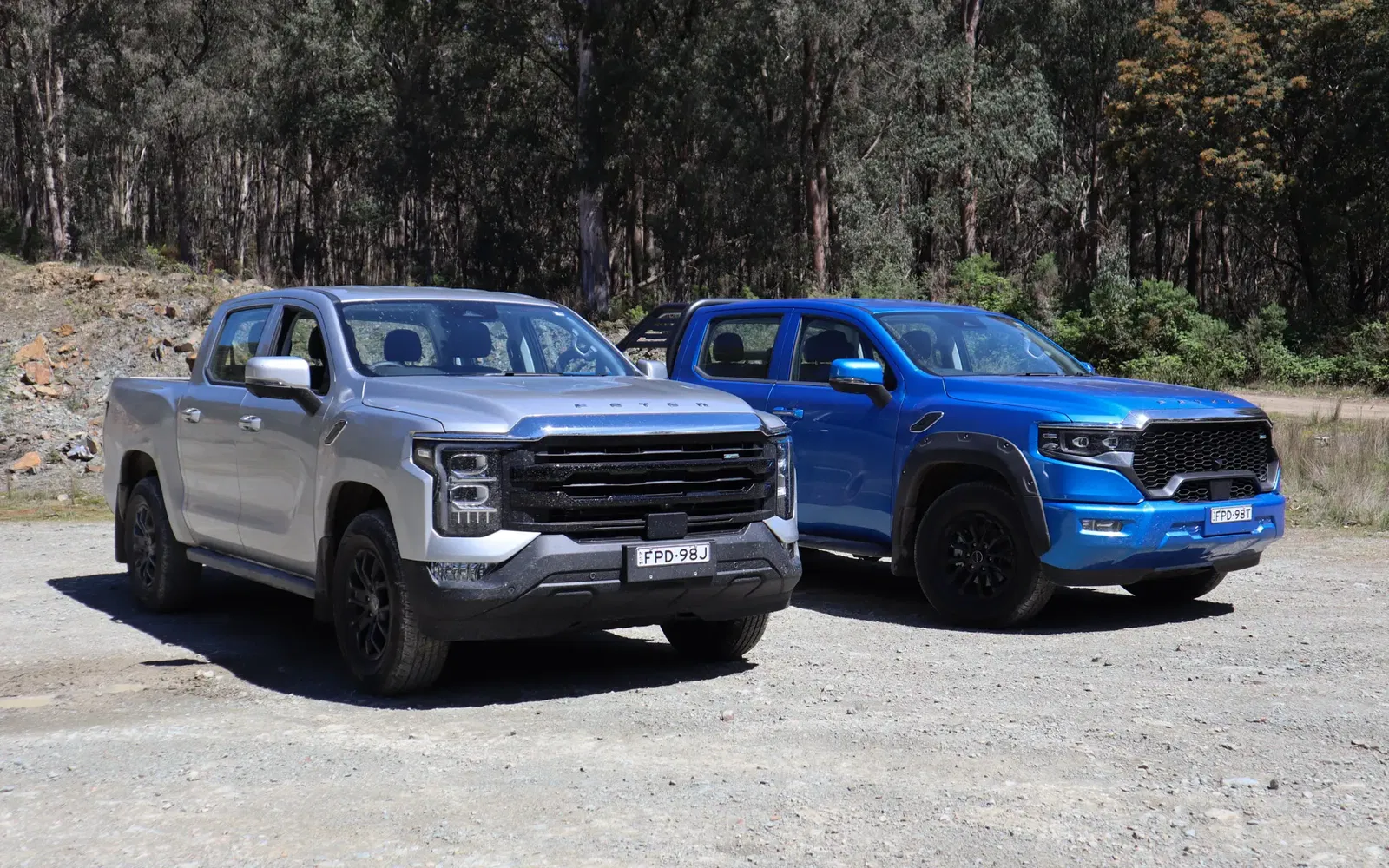
2026 Foton Tunland Review
The 2026 Foton Tunland marks the brand’s return to the Australian car market. But how does this sharply-priced, mild-hybrid ute stack up against its rivals?
B+
UNGRADED

B+
UNGRADED

What people are saying:
Pros
- Great value for money
- High-quality cabin
- Strong Off-Road Capability
Cons
- Weak powertrain
- Incompetent Stop/Start system
- Poor steering feel
Some of you might remember the Foton name. But for the uninitiated, in 2012, the Chinese commercial vehicle manufacturer began a relatively short-lived foray into Australia’s car market, first launching the Tunland ute.
However, by the turn of the decade, the brand had all but disappeared from local showrooms.
Now, both Foton and the Tunland are back in force, ready to take on the highly competitive ute market and re-establish themselves on local shores.
At a glance, the 2026 Foton Tunland looks promising, with sharp pricing, a mild-hybrid powertrain, and plenty of off-road features in the case of the 4X4 models.
But can Foton make it stick the second time around? Time to find out!
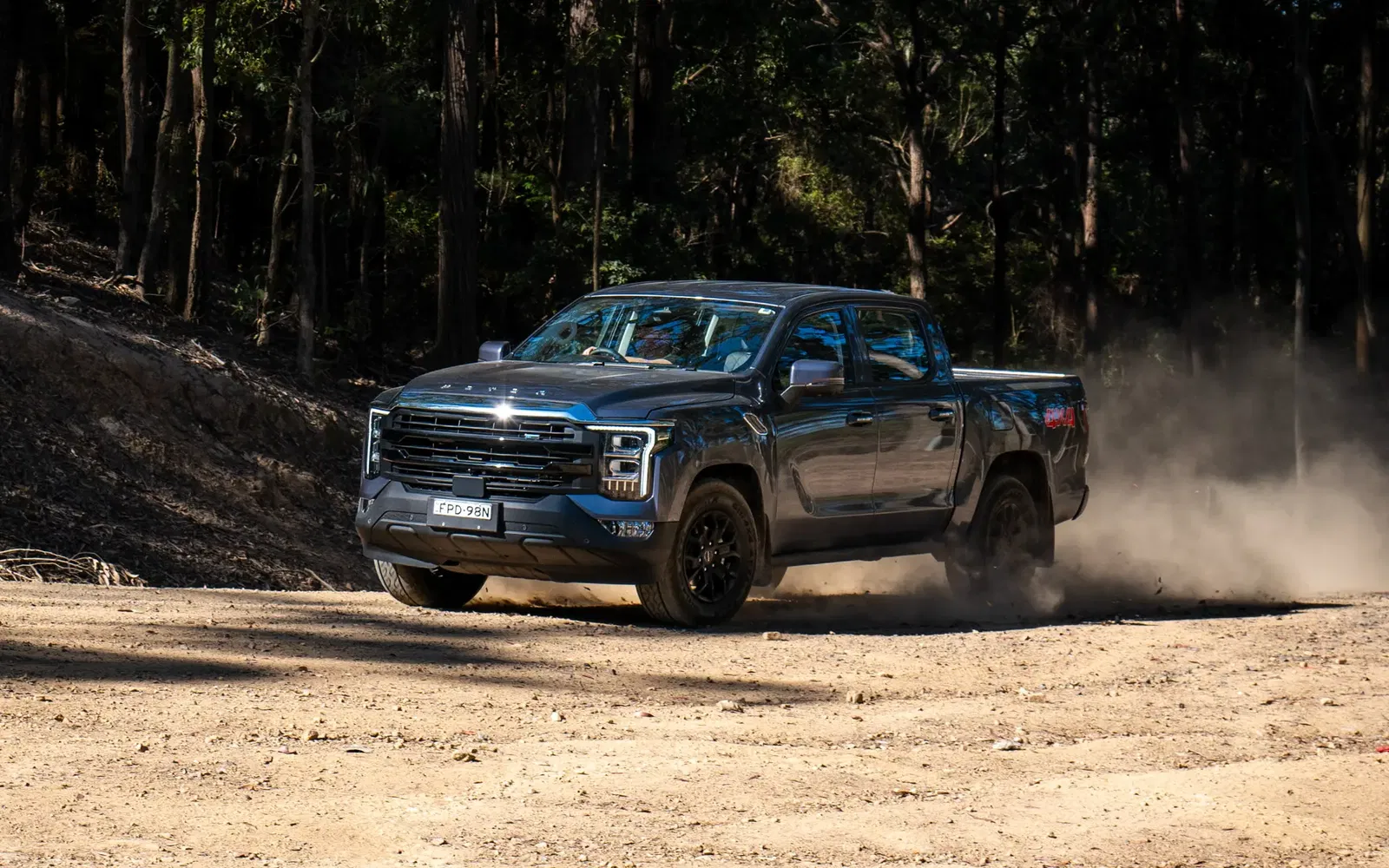
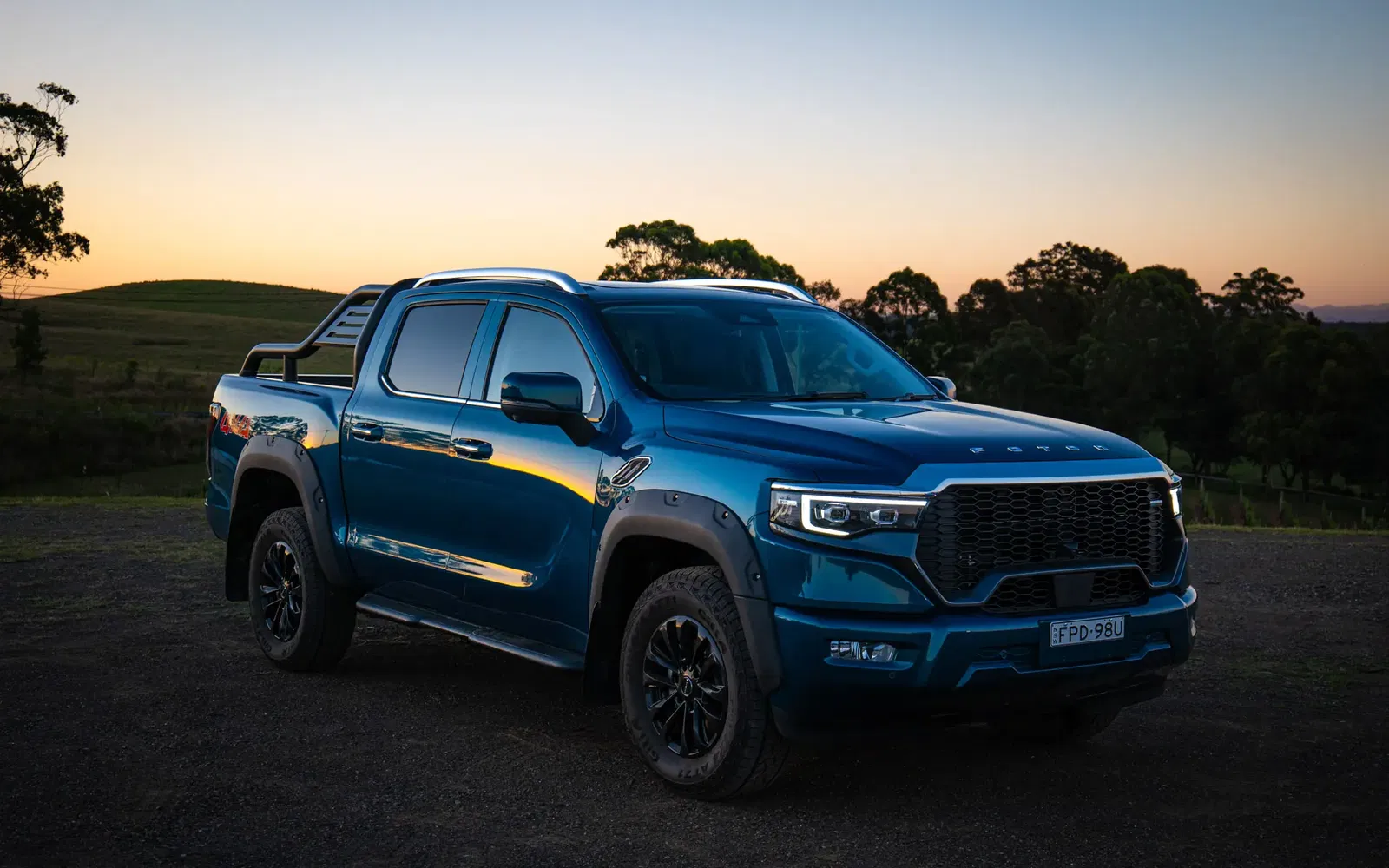
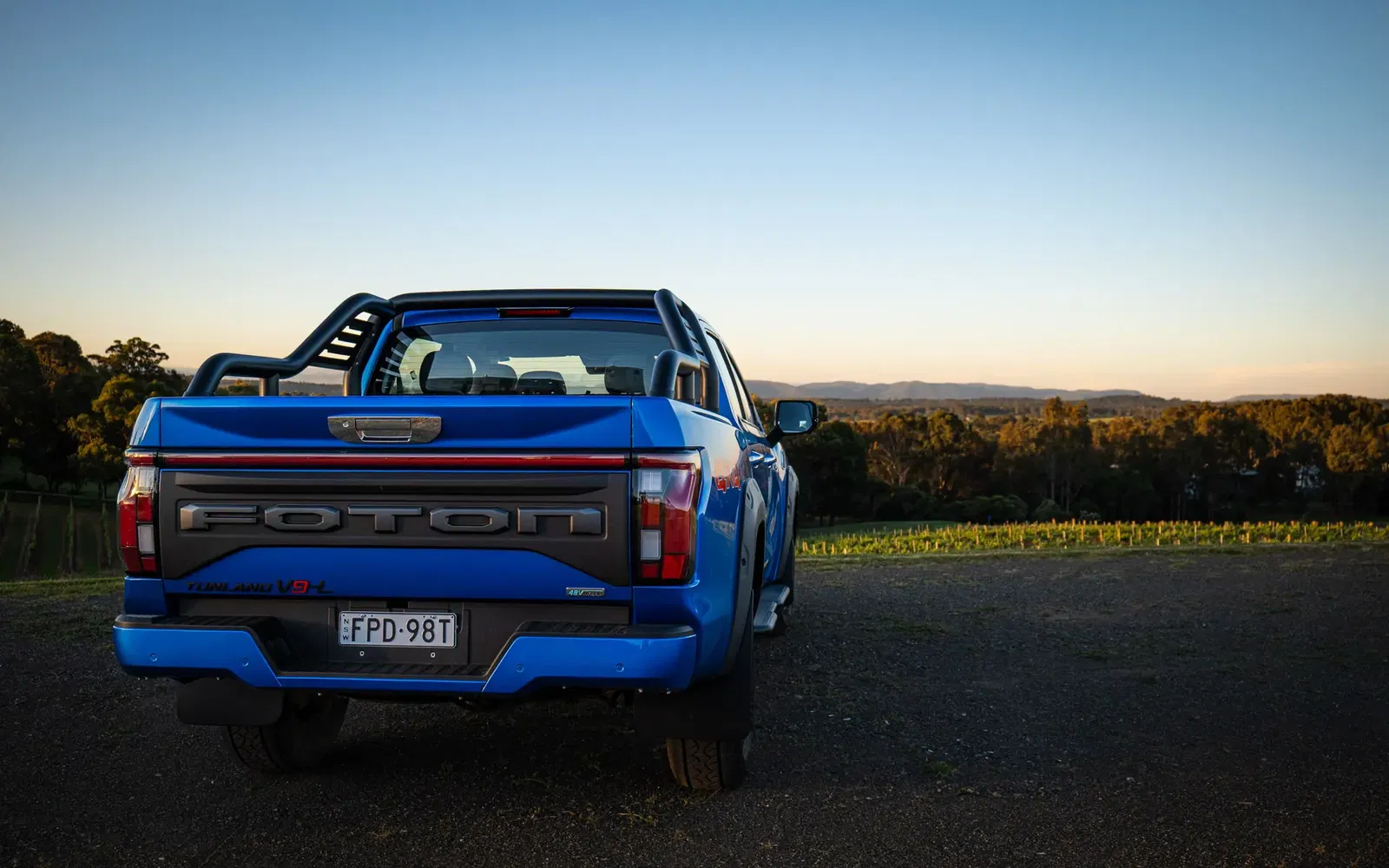
How much does the 2026 Foton Tunland Cost?
Prices for the 2026 Foton Tunland start $39,990 before on-road costs for the entry-level V7-C 4X2 variant. Prices rise to $42,990 for the V7-C 4X4, $45,990 for the V9-L 4X4, and $49,990 for the range-topping V9-S 4X4.
While the Tunland isn’t the cheapest among budget ute offerings, it’s still fairly competitively priced compared to such models as the JAC T9 ( $42,662 - $45,630 before on-roads), the dual-cab GWM Cannon models ($35,990 - $50,990 drive-away), the diesel LDV T60 variants ($45,253 - $53,674 drive-away), and the KGM Musso ($42,500 - $53,000 drive-away), while being larger than all of them.

The V9 models are also priced similarly to the entry-level GWM Cannon Alpha (starting at $51,990 drive-away), the MG U9 ($52,990 drive-away), and LDV Terron 9 ($53,674 drive-away).
Considering you can be halfway up the Tunland ladder before setting foot in a double-cab Ford Ranger pick-up (starting at $43,530 before on-roads) or a diesel double-cab Toyota HiLux ute (starting at $44,820 before on-roads), Foton’s latest offering is shaping up to represent fairly strong value.
2026 Foton Tunland Pricing Before On-road Costs
- V7-C 4X2: $39,990
- V7-C 4X4: $42,990
- V9-L 4X4: $45,990
- V9-S 4X4: $49,990
American Inspiration
The V7 and V9 variants of the 2026 Foton Tunland actually look quite different to each other. With two completely different front-end designs – with the V7 seemingly drawing inspiration from the Ford F-150, while the V9 bears a strong resemblance to the Ram 1500 – you’d be forgiven for thinking they were actually two different models altogether.
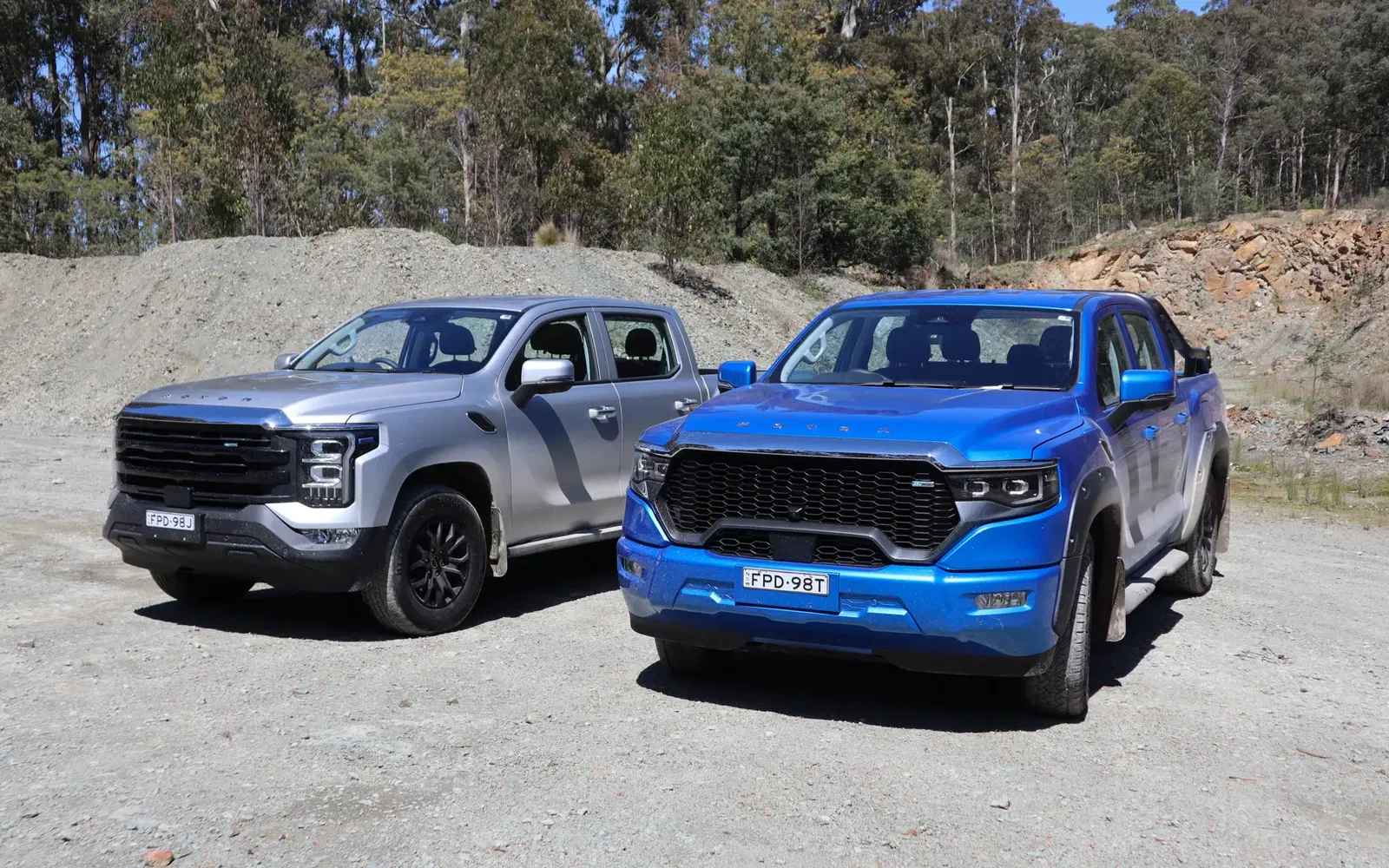
Looking further rearward, the visual distinctions between the two basic variants continue. The V9 features much more pronounced wheel arches than the V7, and its chrome exterior trim, and the addition of a sports bar on the former further set the two models apart.
However, both designs work in their own right. The V7 is reserved yet tasteful, while the V9 appears purposefully rugged. As far as looks are concerned, it’s down to personal preference on which one you prefer.
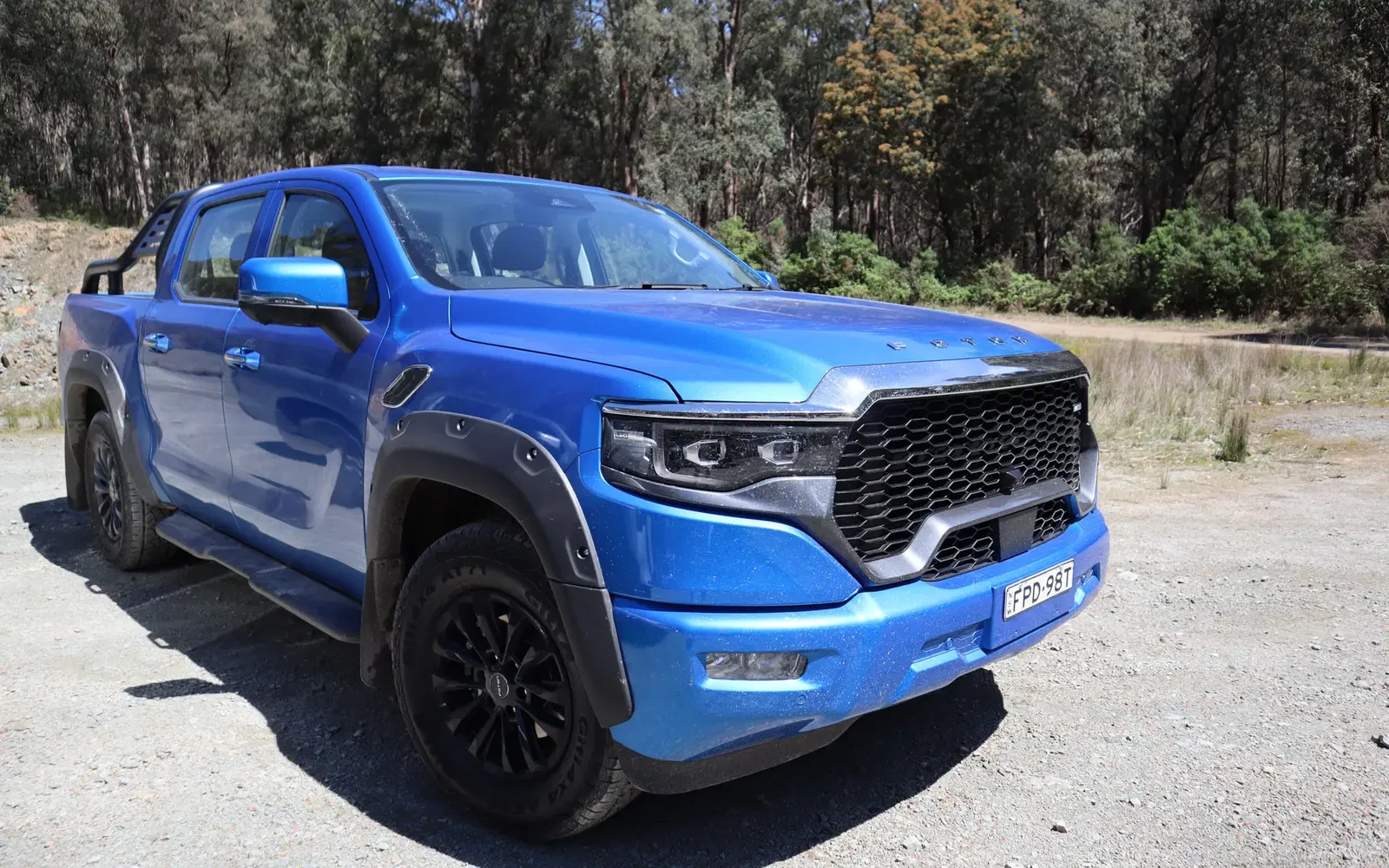
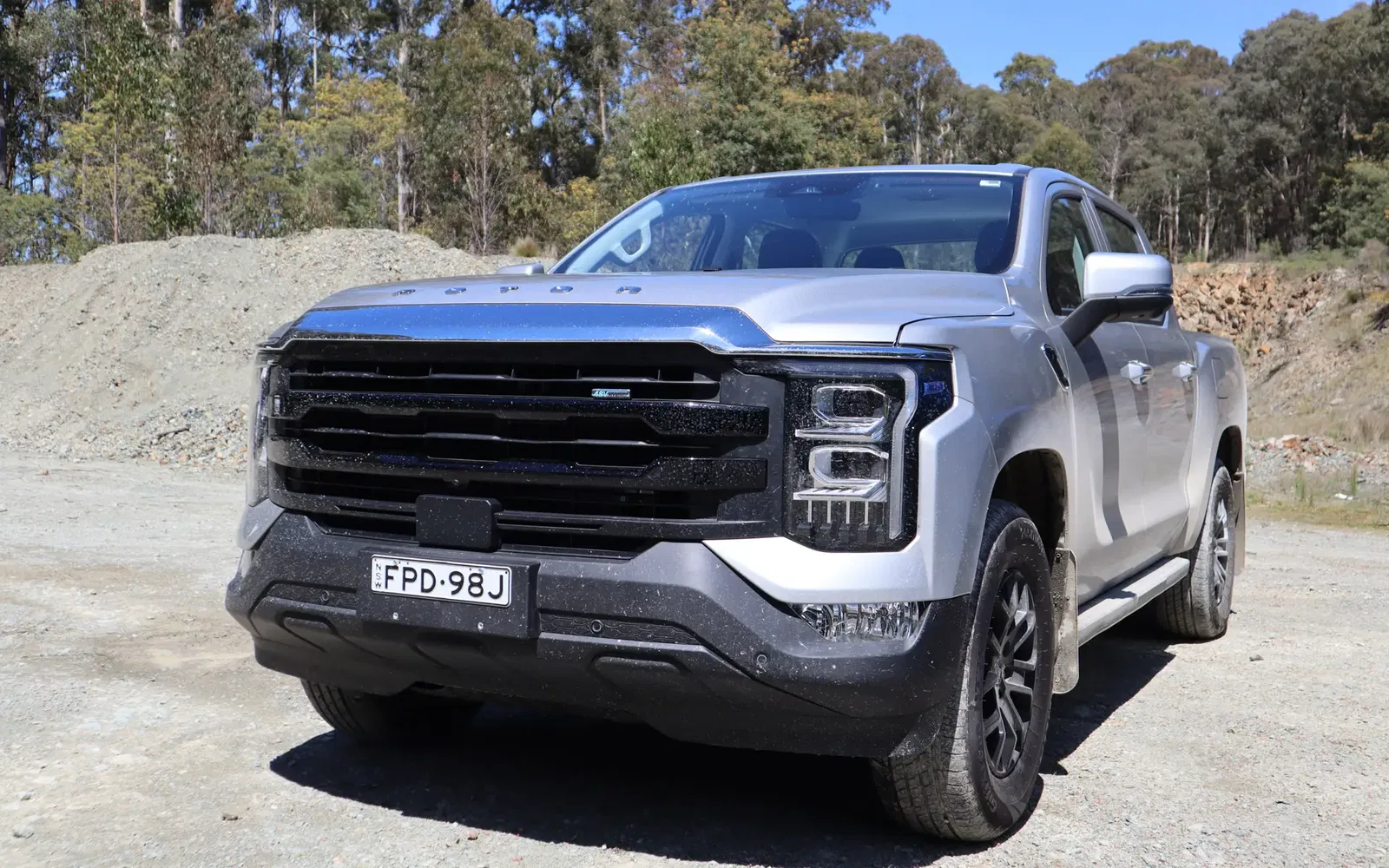
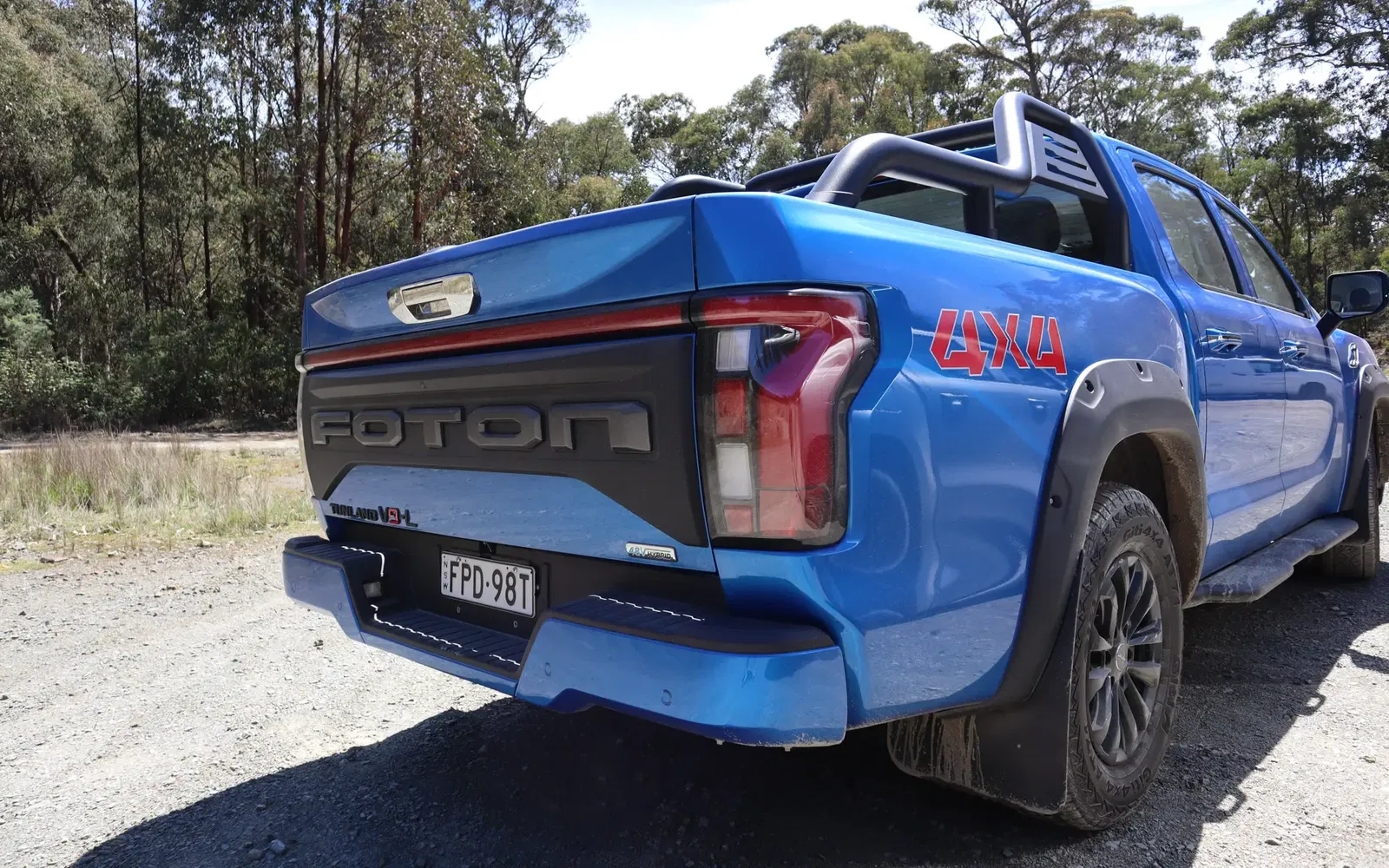
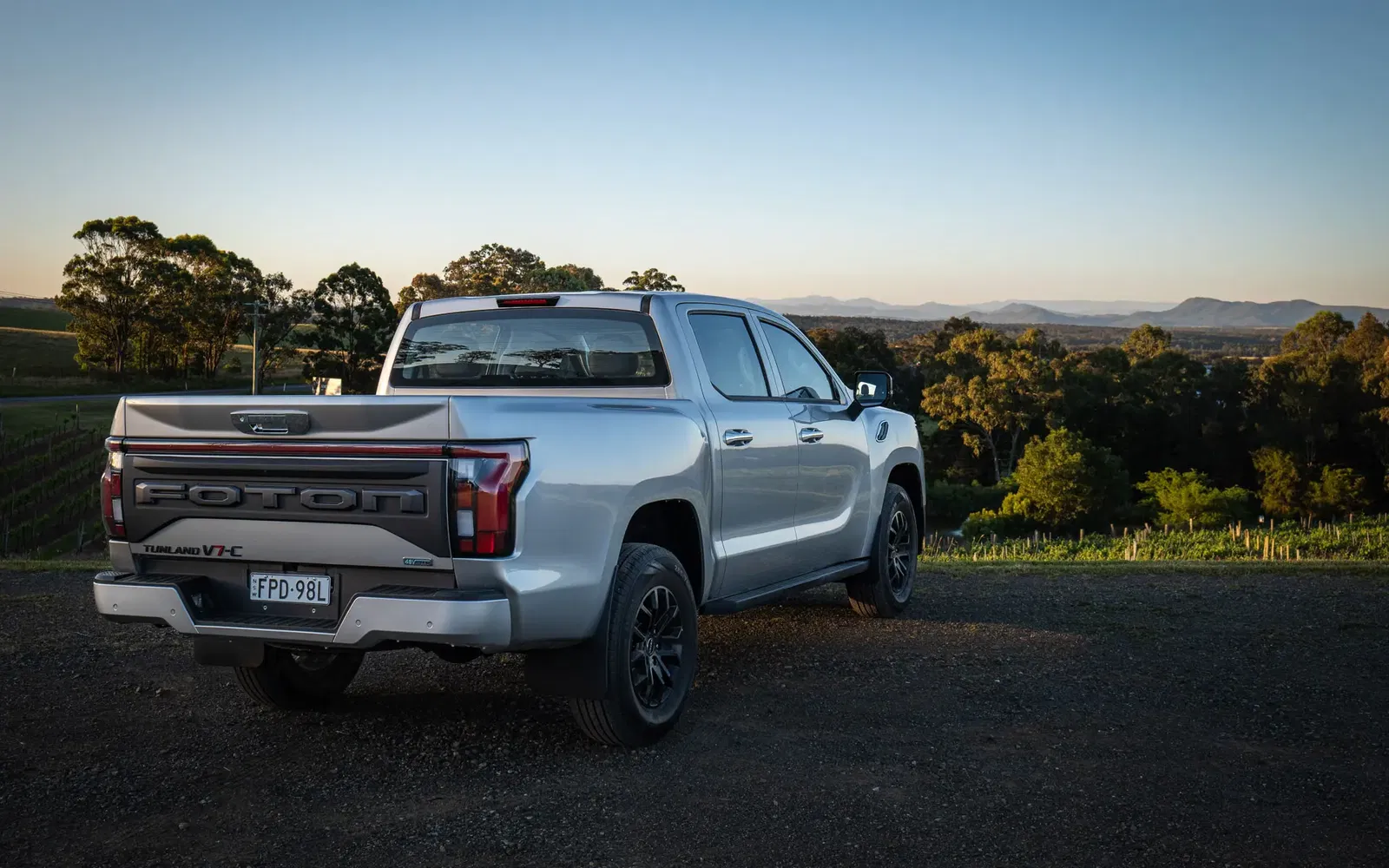
Premium Look and Feel
Step into the front row of any variant of the 2026 Foton Tunland, and you’ll be impressed by how premium the cockpit seems, especially at this price point.
Between the boundless synthetic leather, quilted seats, and metallic touchpoints, you’d be forgiven for thinking you were in a much more expensive vehicle.
Most touchpoints feel pleasant to interact with, although the paddle shifters and the material in the centre of the steering wheel do feel a bit cheap. However, relative to the rest of the front row’s quality, I can certainly forgive these minor shortcomings. The 256 colour ambient lighting featured across the lineup also adds to the premium appeal.
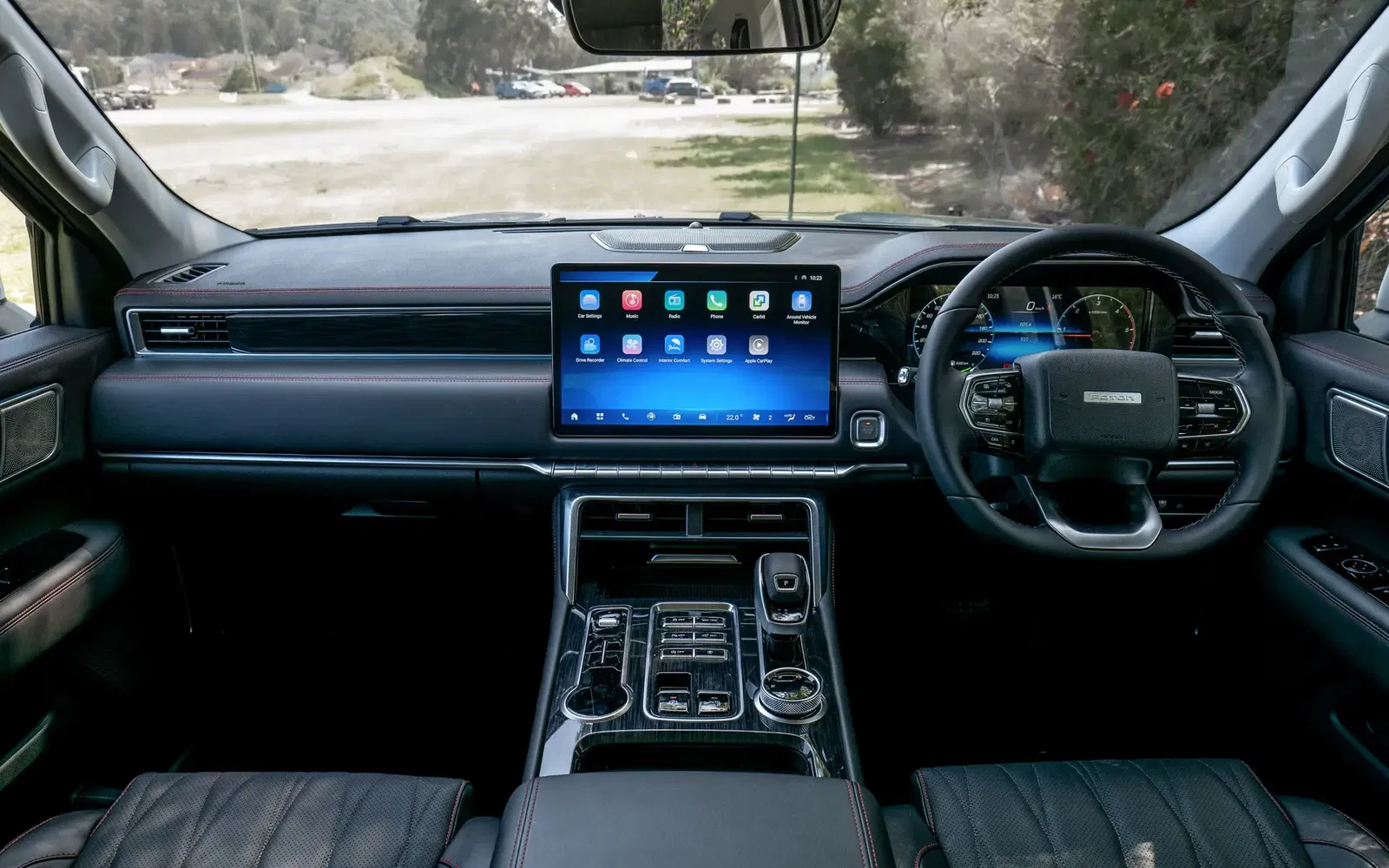
Storage options are extensive in the front row, including the space beneath the centre console, the cavernous centre console armrest storage – which is air conditioned – the massive door bin storage, as well as the accompanying slots on the doors for smaller items.
The V9 models also feature an 18W wireless phone charger on the centre console, which can be neatly covered with a small trap door. While this space lacks the wireless charger in the V7 models, it still acts as useful storage.
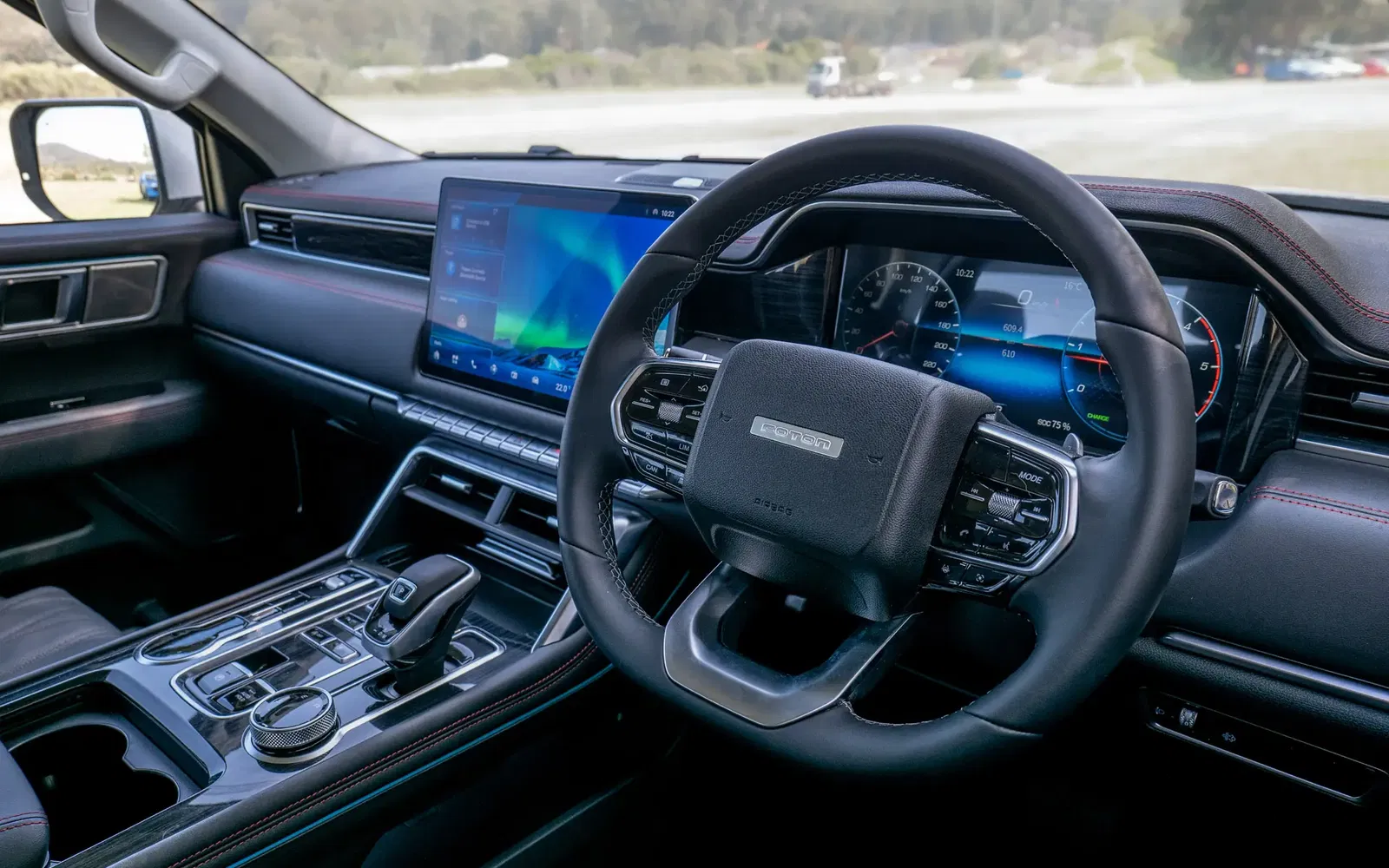
Aside from the wireless phone charger, front-seat occupants can further meet their charging needs with the two USB-A slots below the centre console, although USB-C ports are noticeably absent.
The 14.6-inch infotainment touchscreen is fairly easy to navigate once you get your head around it. The bottom navigation bar makes it particularly easy to make your way through the system. It’s compatible with wireless Apple CarPlay from launch, although Tunland owners will have to wait until Q1 2026 for Android Auto, which will be available through an update from a Foton service centre.
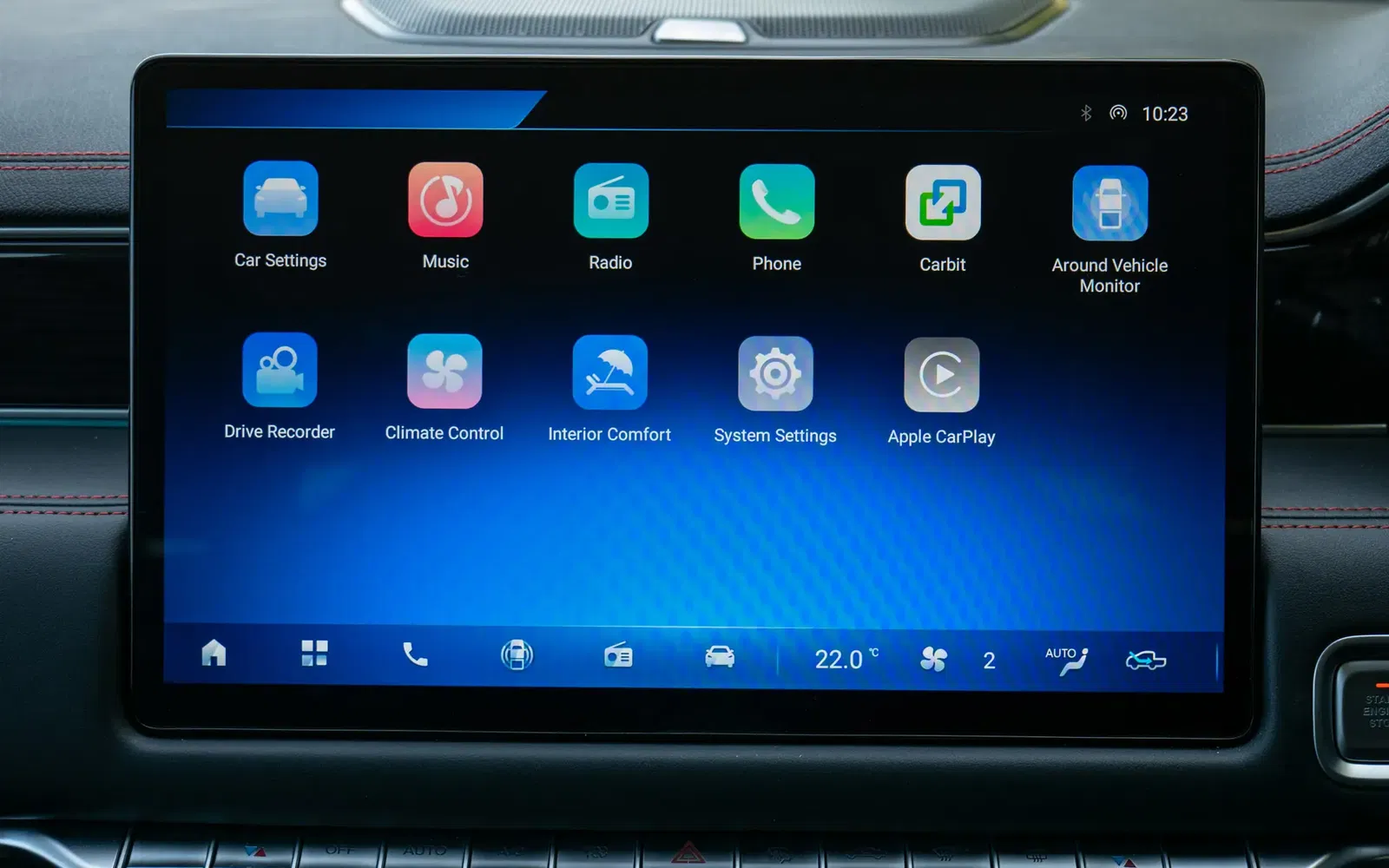
Arguably, the same cannot be said for the 12.3-inch digital instrument cluster. While being highly customisable, with several different layouts, themes, and options for information displays, things like fuel economy can take multiple clicks through the system to get to. Once you figure out how the system works, it’s usable, but there’s certainly a learning curve at the very least.
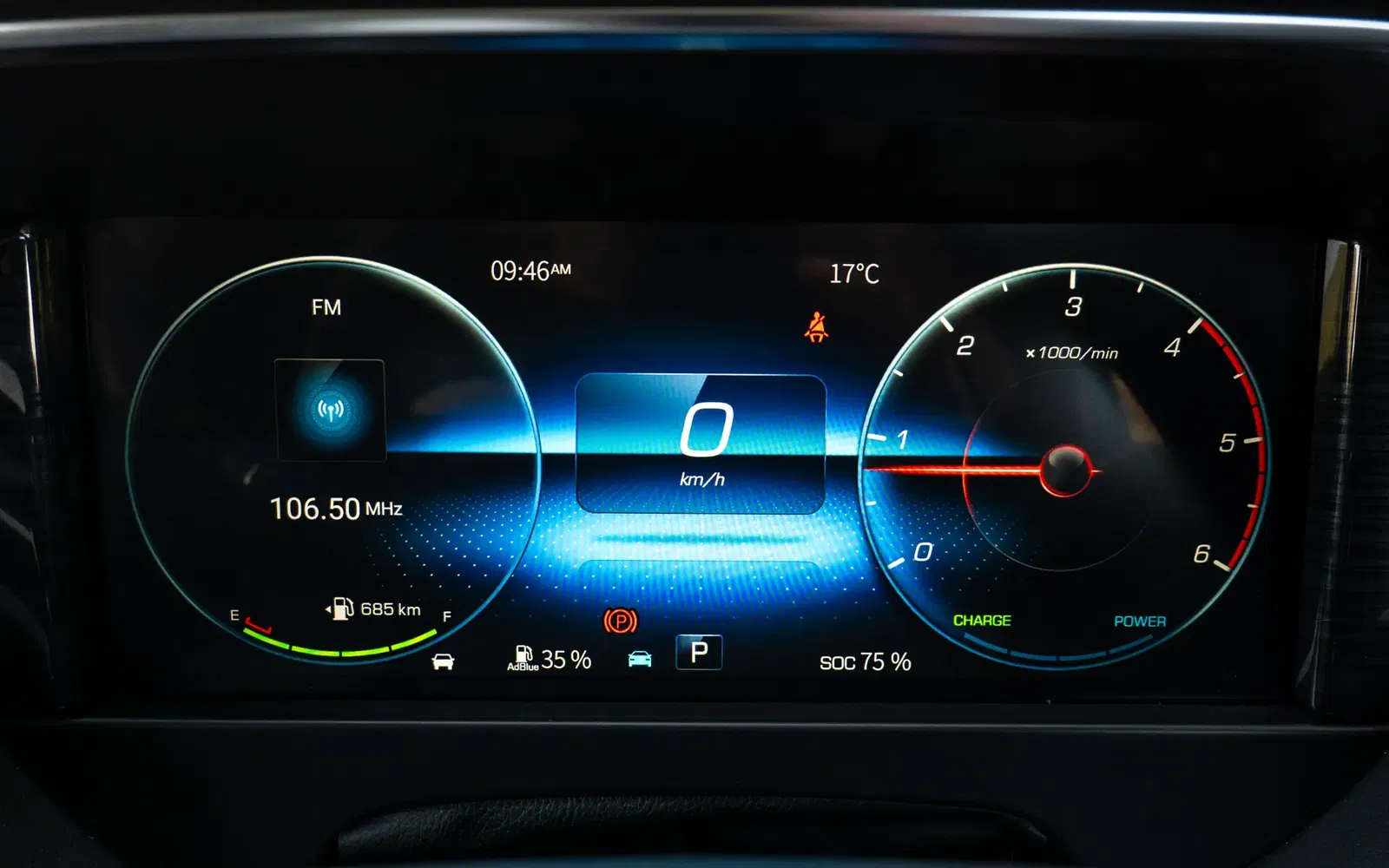
The Tunland earns itself some points in my books for the inclusion of physical air conditioning controls. While the air conditioning menu opens on the infotainment screen every single time the controls are used, which feels slightly unnecessary and a bit intrusive, the up and down buttons are simple and intuitive.
Visibility out is relatively strong, and while you are conscious of the bonnet, it doesn’t look vast from the driver’s seat. The A-pillars aren’t particularly thick either, and there’s also decent visibility beyond the front of the wing mirror.
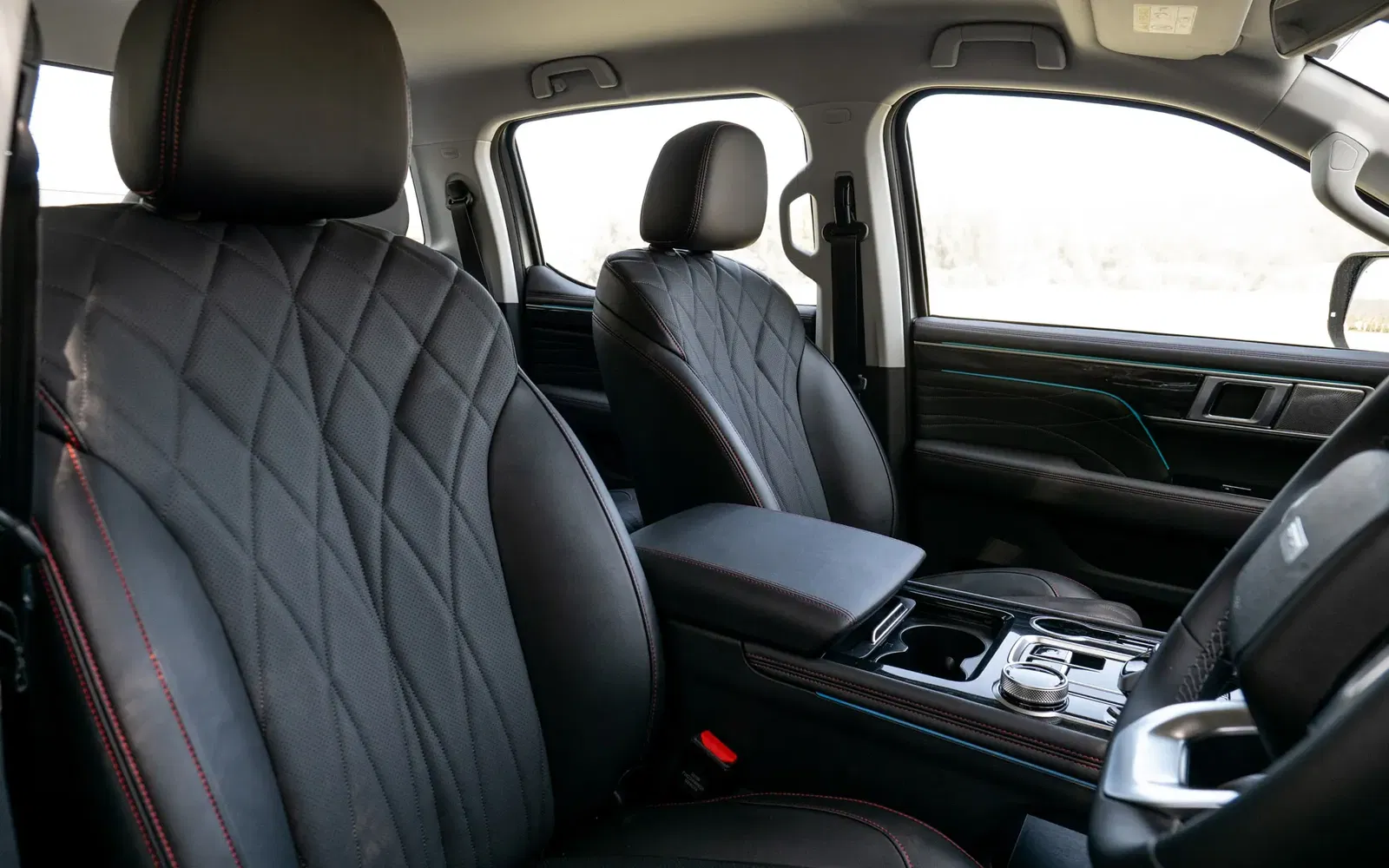
The seats are also comfortable and properly bolstered. In the V7 variants, they’re manually adjustable (six ways for the driver and four ways for the front passenger), while the V9 models gain electric adjustability as well as four-way lumbar adjustment. Regardless of which you choose, it’s easy to get comfortable across all variants.
Overall, the Foton Tunland’s front row is a very pleasant place to be, and feels much more luxurious than its price tag would suggest, regardless of what variant you’re in.
Space for Three
In the rear seat of the 2026 Foton Tunland, I found of plenty of knee-room behind my own driving position (5’11”) as well as strong headroom and decent shoulder room.
The Tunland’s second row also lacks a transmission tunnel, which not only makes it more comfortable for passengers sitting three abreast, but it also frees up space along the floor for when the rear seats are folded upwards. Its rear seats can also be folded forward, allowing the space on top of the seat backs to be used for storage as well.
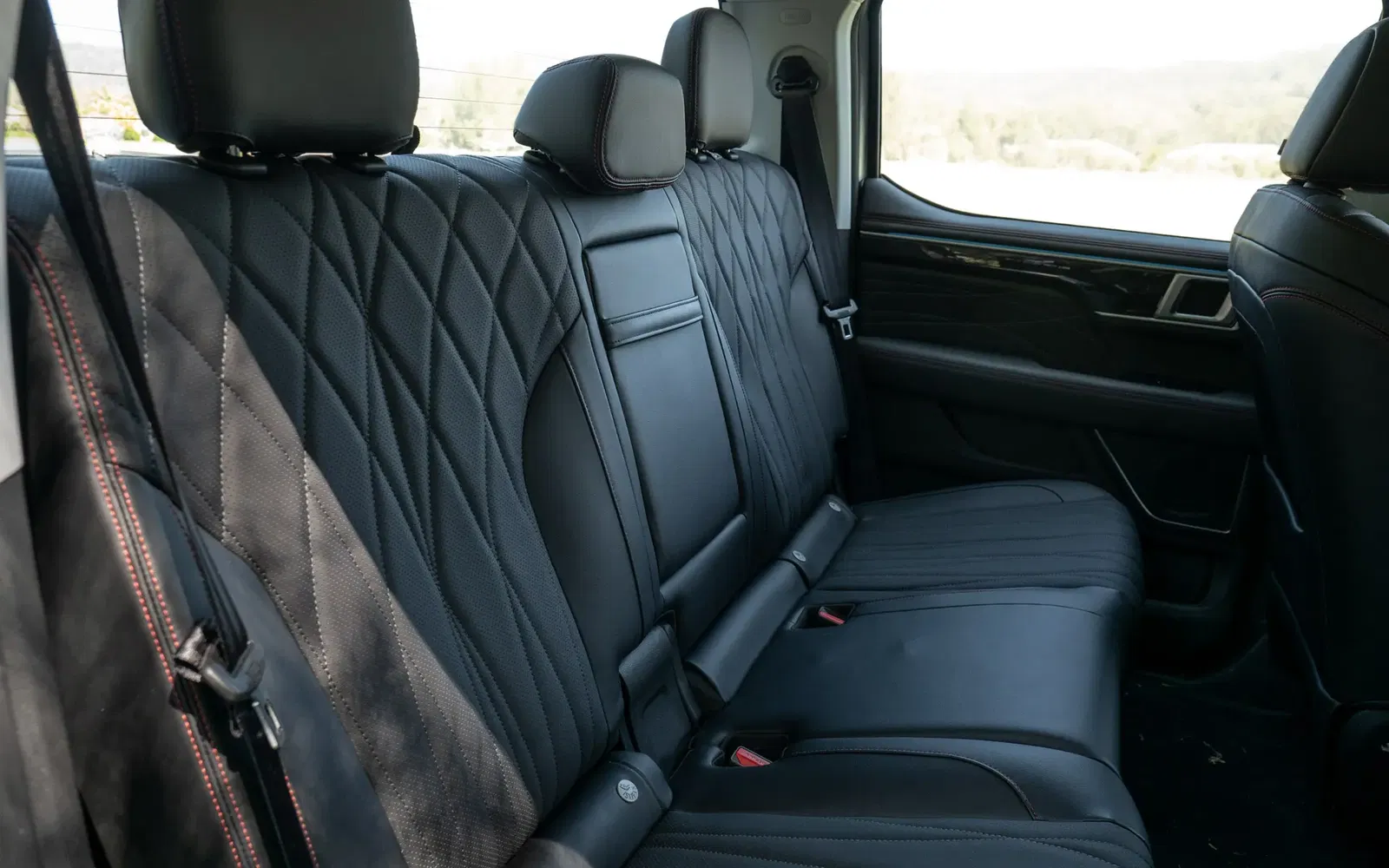
When it comes to amenities, all variants of the Foton Tunland receive a centre console armrest with cupholders as well as rear air vents. The V9 model grade gains two more USB-A ports and a 220V/300W Vehicle-to-Load power socket below the air vents.
The Foton Tunland’s rear seat can seat three passengers comfortably and effectively accommodate space for cargo, while also boasting some decent amenities in the V9 variant.
Makes Use of Its Size
The 2026 Foton Tunland certainly makes use of its size when it comes to practicality.
Its tub measures 1,577mm long, 1,650mm wide, 530mm high, with a 1,240mm wheel arch gap. It goes without saying that the Tunland can comfortably accommodate a standard Australian pallet (1,165mm x 1,165mm).
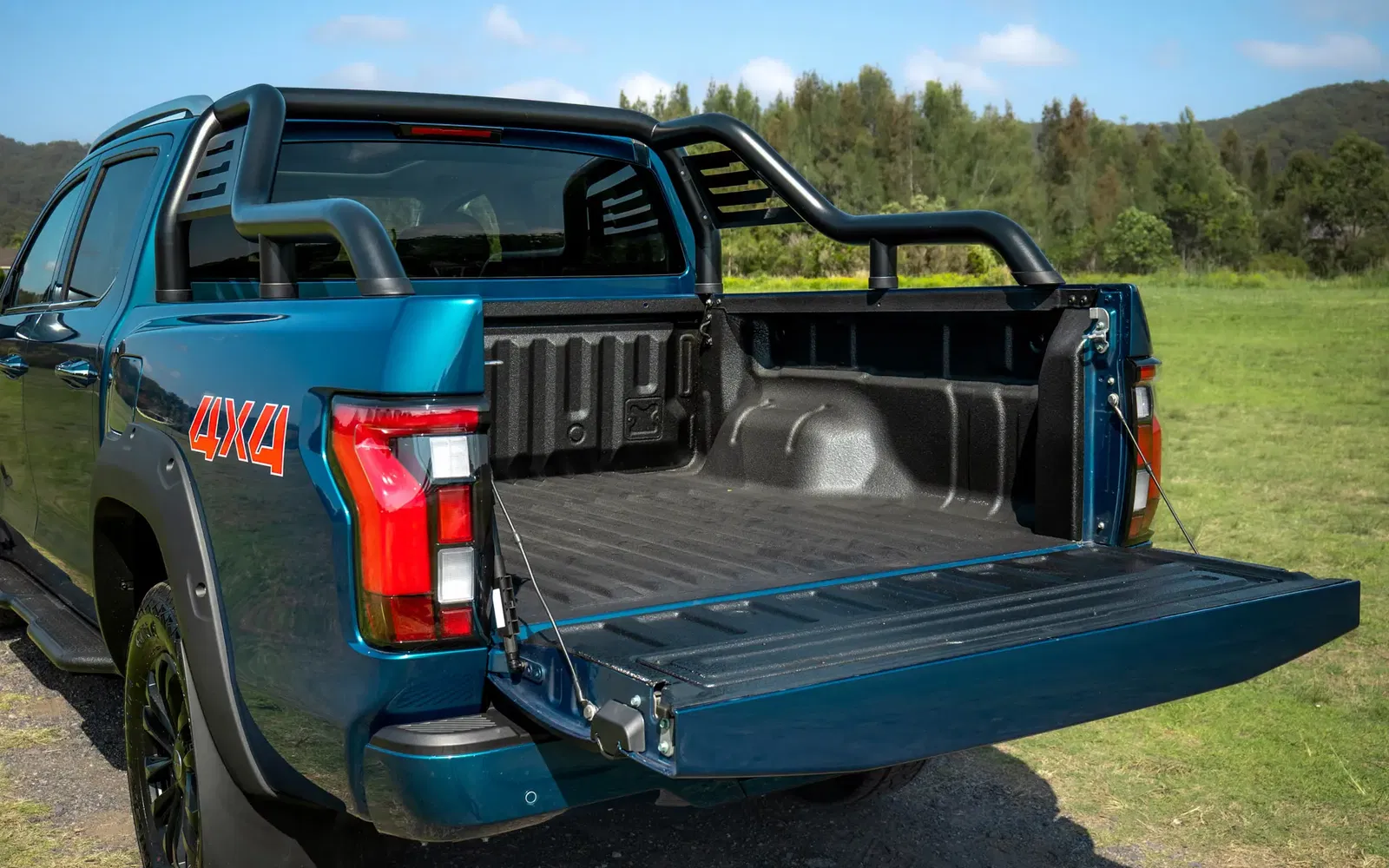
Tailgate assist struts, spray-in tub liner, and an inner rope hook are also standard features in the Tunland’s tub across the range.
Payloads are all fairly strong, too. The entry-level V7-C 4X2 can accommodate the heaviest payload of the Tunland range at 1,115kg, followed by its 4X4 counterpart (995kg). The V9 variants, which ride on multi-link rear suspension as opposed to the leaf springs used in the V7 variants, can both carry 995kg.
2026 Foton Tunland Tub Dimensions
- Length: 1,577mm
- Width: 1,650mm
- Height: 530mm
- Wheel Arch Gap: 1,240mm
2026 Foton Tunland Payloads
- V7-C 4X2: 1,115kg
- V7-C 4X4: 1,050kg
- V9-L 4X4: 995kg
- V9-S 4X4: 995kg
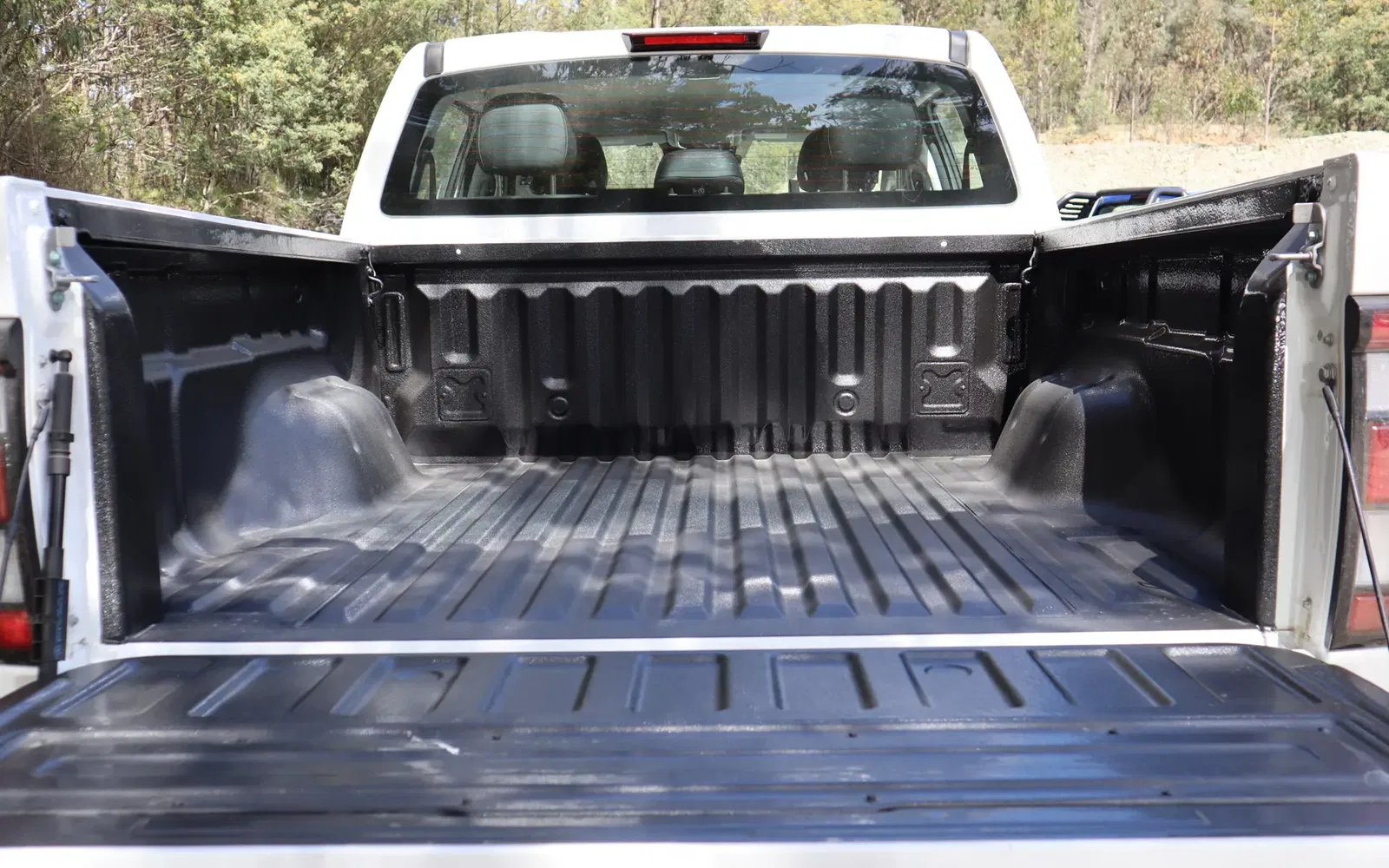
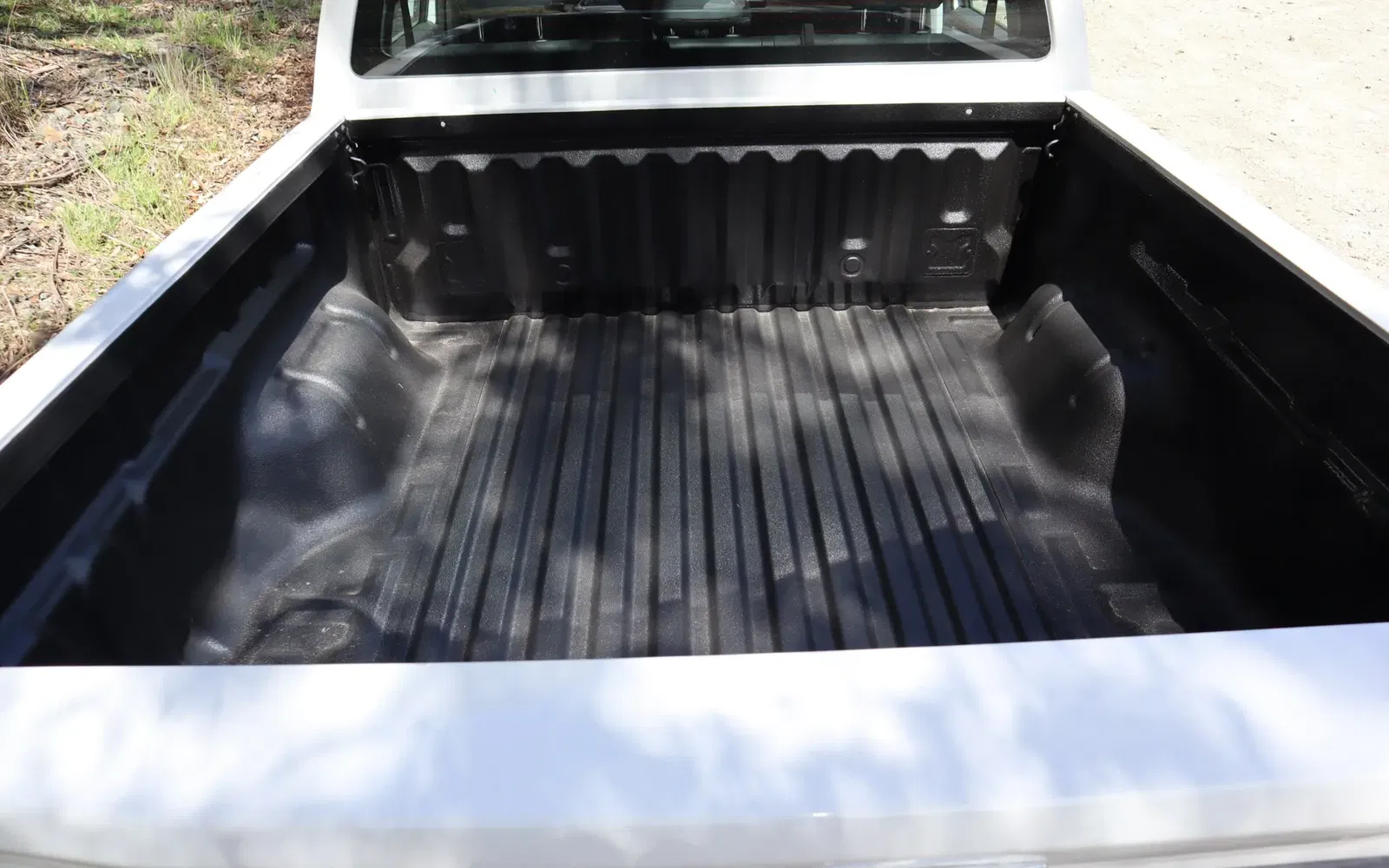
The Weakest Link
All variants of the 2026 Foton Tunland are powered by a 2.0-litre four-cylinder diesel engine mated to a 48V mild-hybrid system – which operates at low revs for low-end torque – and an eight-speed automatic transmission.
The Tunland is available in both 4X2 and 4X4 guises, but all variants produce 120kW and 450Nm.
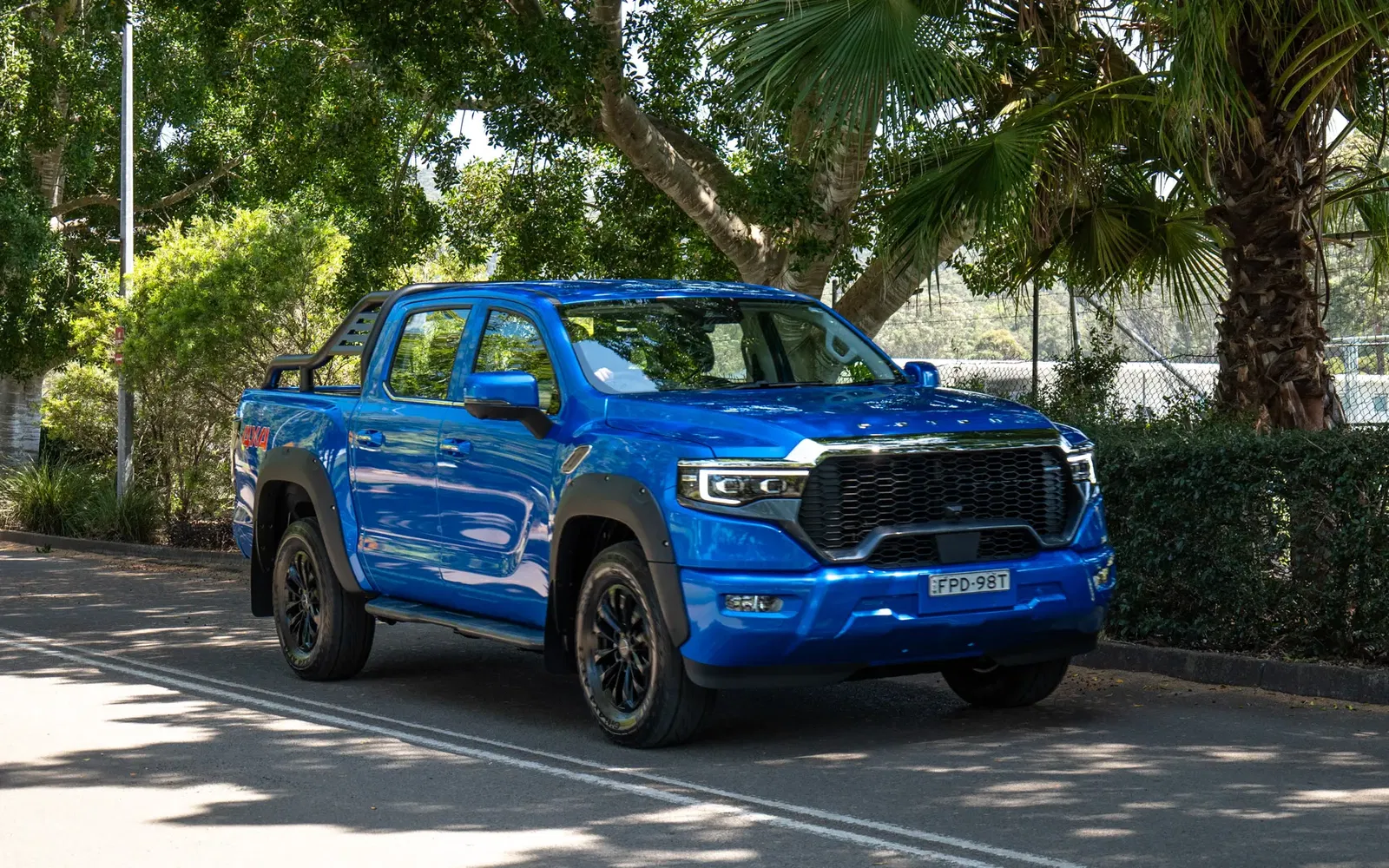
Its powertrain is arguably the Tunland’s weakest link. While its output figures are comparable to similarly priced, albeit smaller ute offerings like the JAC T9 (120kW/410Nm) and, the GWM Cannon (120kW/400Nm), KGM Musso (133kW/400Nm) – smaller being the operative word – its performance is dwarfed by the LDV Terron 9 (163kW/520Nm) and its MG U9 (160kW/520Nm) sibling.
If the Tunland were smaller, its outputs probably wouldn’t be as big an issue, but with a kerb weight of 2,190kg in the case of the V7 4x2 (the lightest in the range), its power-to-weight ratio works out at just shy of 55kW per tonne.
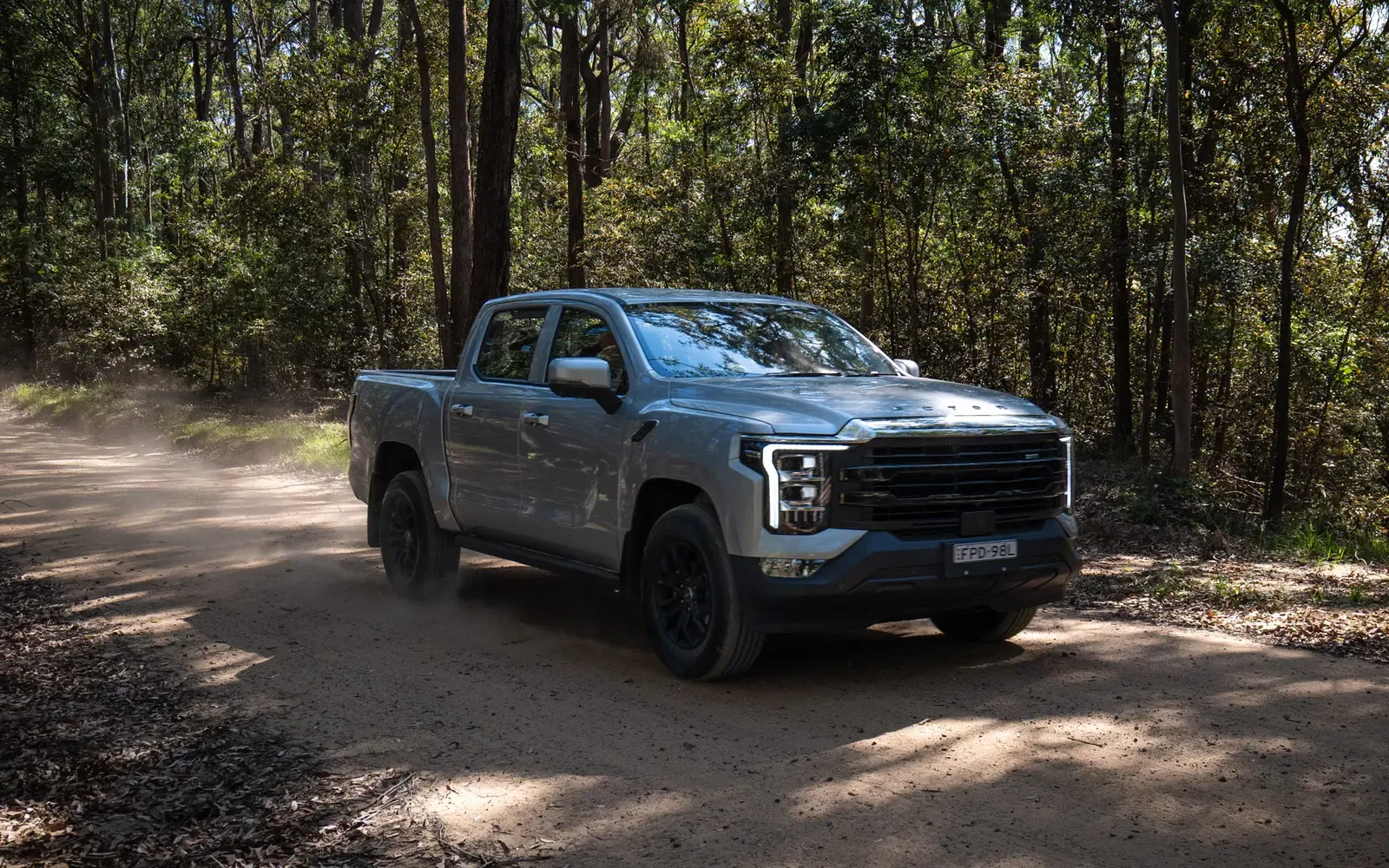
Claimed combined fuel economy is 8.0L/100km across the range, but during my time with the Tunland, the lowest number I was able to record was 9.2L/100km.
Despite having a mild-hybrid system onboard, neither its performance figures nor its fuel economy are particularly impressive.
Rough Around the Edges
My time with the Foton Tunland on the road was spent primarily on country backroads with relatively brief stints of motorway and urban driving.
Admittedly, there’s a lot about the Tunland’s driving experience that lacks refinement. Wind and road noise are evident when speeds pick up. However, the Tunland’s vocal engine does drown out quite a lot of these sounds.
The 2.0-litre four-cylinder diesel feels as underpowered as its specs would suggest. Acceleration is as lengthy a process as it is a loud one, as the Tunland drags itself up to speed with an accompanying drone.

While the Tunland does have a mild-hybrid system, you could convince me otherwise, as you never seem to get any evident benefit from it.
The stop/start system also isn’t great. There were certainly some lengthy delays between asking for power at a junction and the engine firing back into life and setting off during my time with it.
Steering feedback is largely lacking, and it often feels disconnected and non-linear. It also has an unpleasantly thick feeling on-centre.
The ‘Eco’, ‘Standard’, and ‘Sport’ modes offered in the V7 4X4 and V9 variants also don’t seem to make any meaningful difference in how the Tunland behaves, at least in my experience.
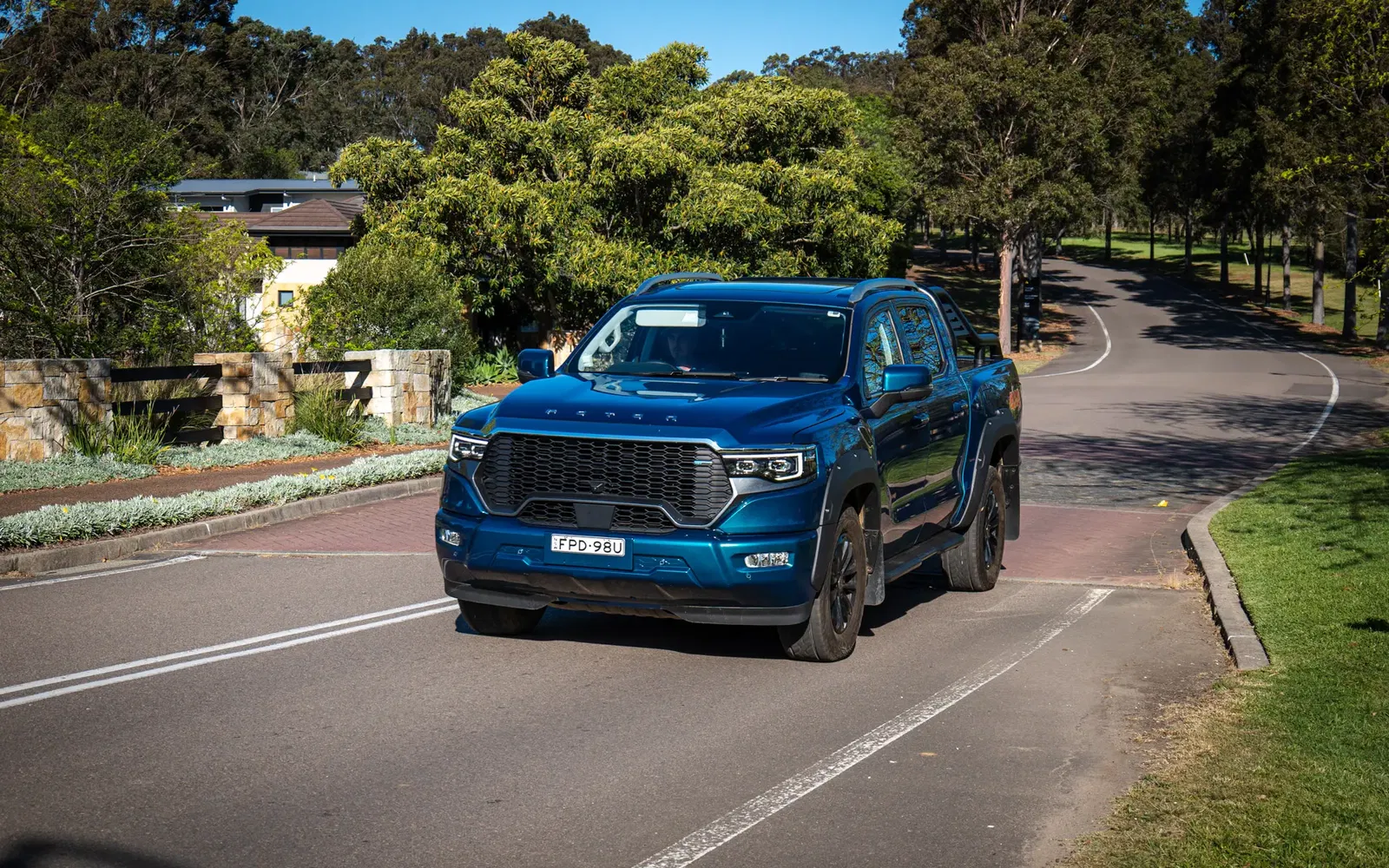
However, it’s not all doom and gloom. The Tunland still has its strong suits.
Firstly, the Tunland actually rides quite well. While I wouldn’t call it perfectly silky smooth – it is a ute after all – it’s not uncomfortable. The ride in the rear leaf spring V7 variants is a bit harsher than in V9 models, which use multi-link rear suspension, but they actually don’t feel hugely different to each other.
The biggest surprise for me, though, was how the Tunland behaves dynamically. My god, there’s a chassis on this thing! I had the chance to hustle the V9 through a particularly fast, twisty and technical section of backroad and was taken aback by just how sorted it is.
Even when faced with constant cornering, the Tunland controls its body and mass rather well. In situations when you’d expect to feel the makings of understeer, it just sticks.
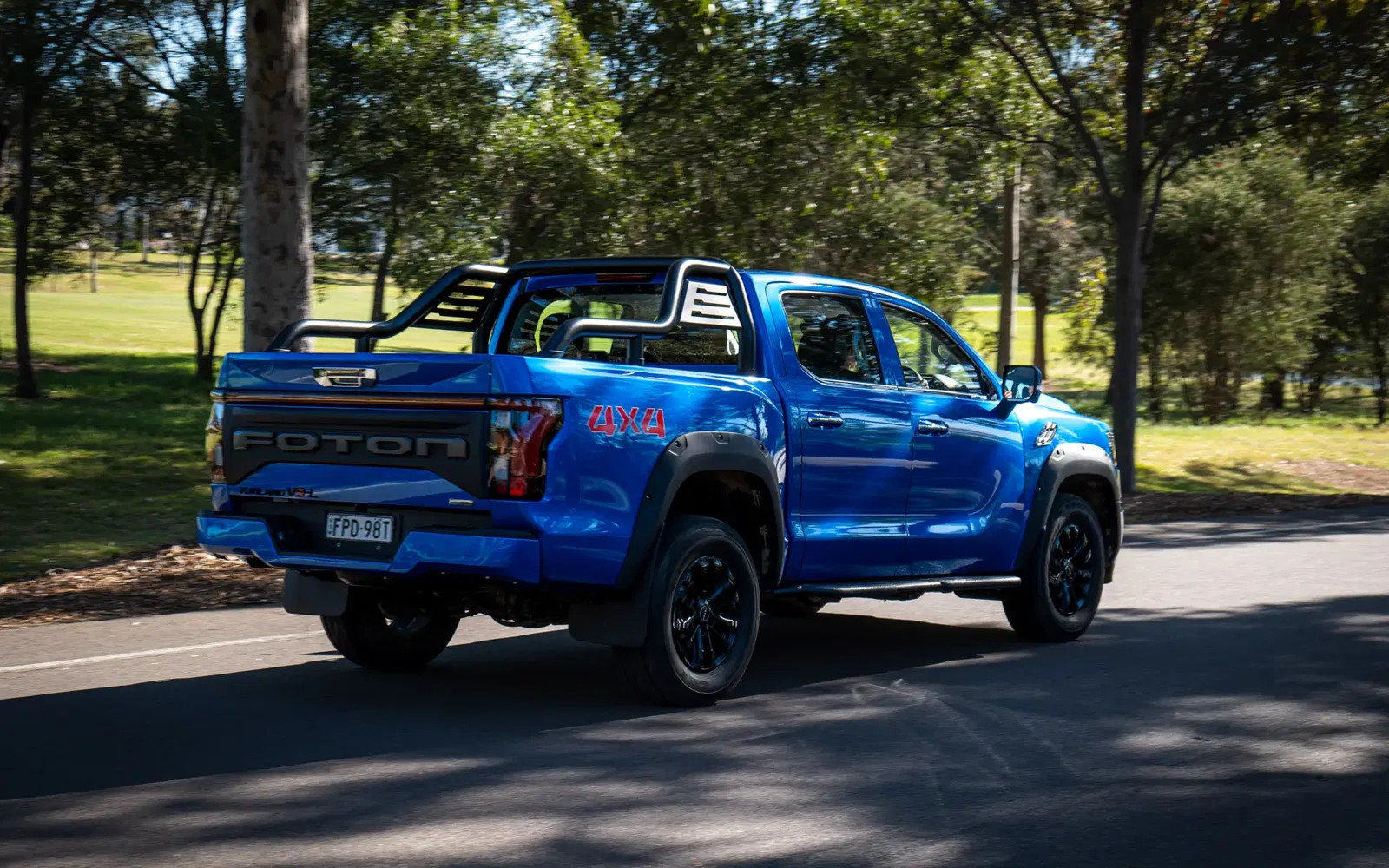
Maybe if I’d been in the V7, things would’ve been different, but the Tunland’s backroad performance is extremely impressive, especially for a vehicle mainly designed to carry and tow things.
As far as the ADAS safety suite is concerned, in my experience, I was never particularly conscious of many annoying beeps or bongs, and overall, the systems felt sensibly calibrated. Adaptive Cruise Control seemed to work as I expected it to, and Lane Keeping intervened appropriately.
There’s no getting around the fact that the Foton Tunland certainly has its rougher edges. Perhaps as the model evolves over the years, things like the stop/start system could be fine-tuned. The powertrain, on the other hand, is probably a more difficult problem to fix. But, if you can stomach the faults, the Tunland impresses in the ride and handling department.
Take It In Its Stride
Beyond the entry-level 4X2 model, the 4X4 Foton Tunland variants come equipped with some decent off-road kit.
All three 4X4 models have a rear differential lock, while the range-topping V9-S also gets a front diff lock. 2H, 4H, and 4L modes can be selected for the part-time 4WD system, or the driver can opt for sand, mud or snow modes via the drive mode selector. Furthermore, the 4X4 variants of the Tunland also wear all-terrain tyres.
As for specs, the Tunland has a breakover angle of 21 degrees, an approach angle of 28 degrees, and a departure angle of 26 degrees. Ground clearance sits at 240mm, while all models have a wading depth of 700mm.
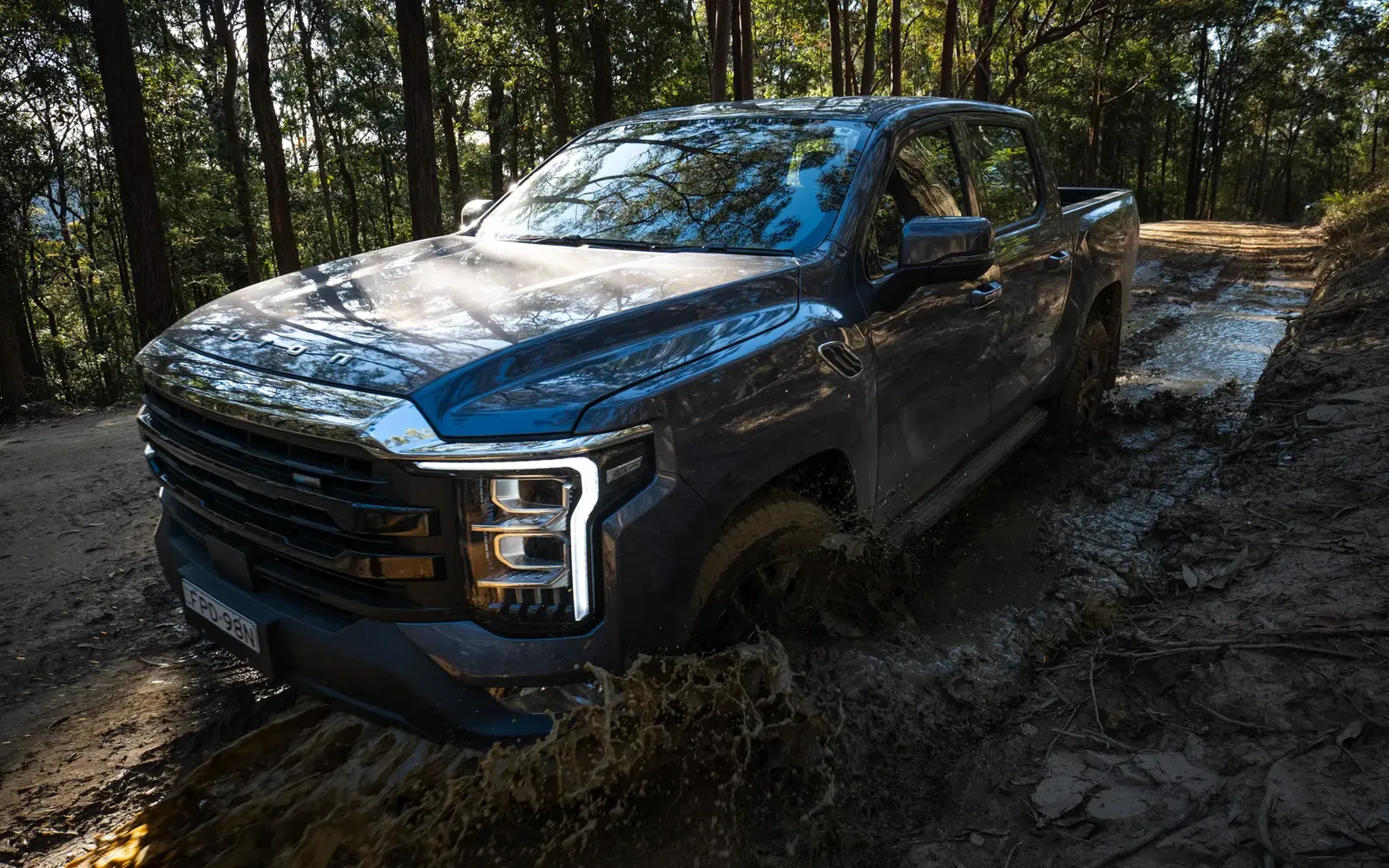
Compared to immediate rivals such as the MG U9, LDV Terron 9, and GWM Cannon Alpha, these are solid numbers. In most specs, it’s within one degree of the U9 and Terron 9, but the Tunland has a 20mm higher ground clearance and a wading depth 150mm deeper. Even still, its wading depth is outdone by the Cannon Alpha’s 800mm.
Admittedly, the off-road course I tested the Tunland on wasn’t exactly challenging, but it still had its fair share of rough terrain, steep hills and muddy puddles. In any case, the Tunland took it all in its stride.
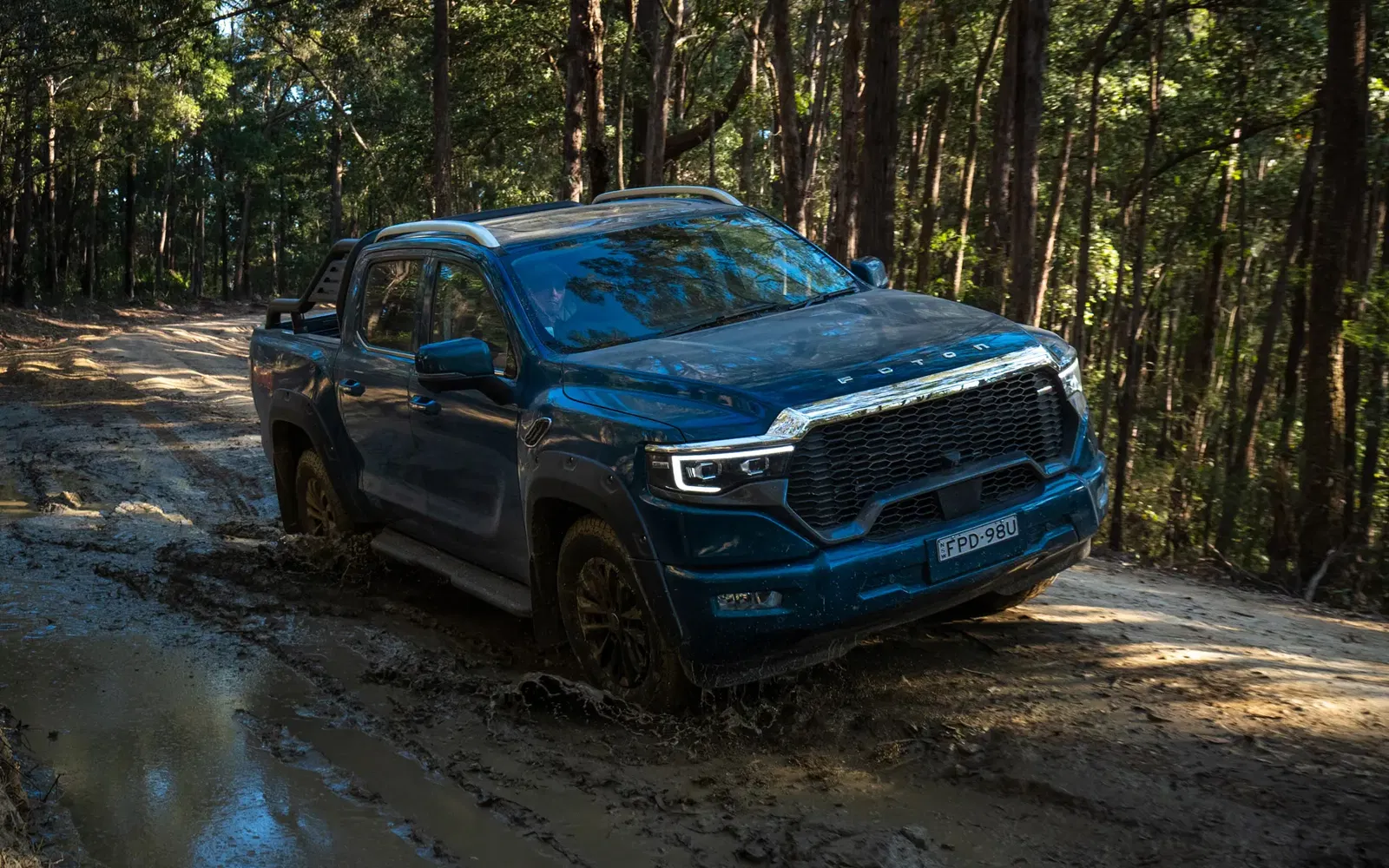
Aside from the appropriate pedal inputs to push forward, and steering to point it in the right direction, the Tunland never asked for much in the way of off-road aptitude from its driver.
All variants of the Tunland are equipped with a 360-degree panoramic view monitor, as well as a transparent chassis view monitor, tools that made the already easy-going off-road experience a breeze.
The full extent of the Tunland’s off-road capabilities remains to be fully realised, but initially at least, it’s a strong showing.
2026 Foton Tunland Off-Road Specs
- Minimum Ground Clearance: 240mm
- Break Over Angle: 21 degrees
- Approach Angle: 28 degrees
- Departure Angle: 26 degrees
- Wading Depth: 700mm
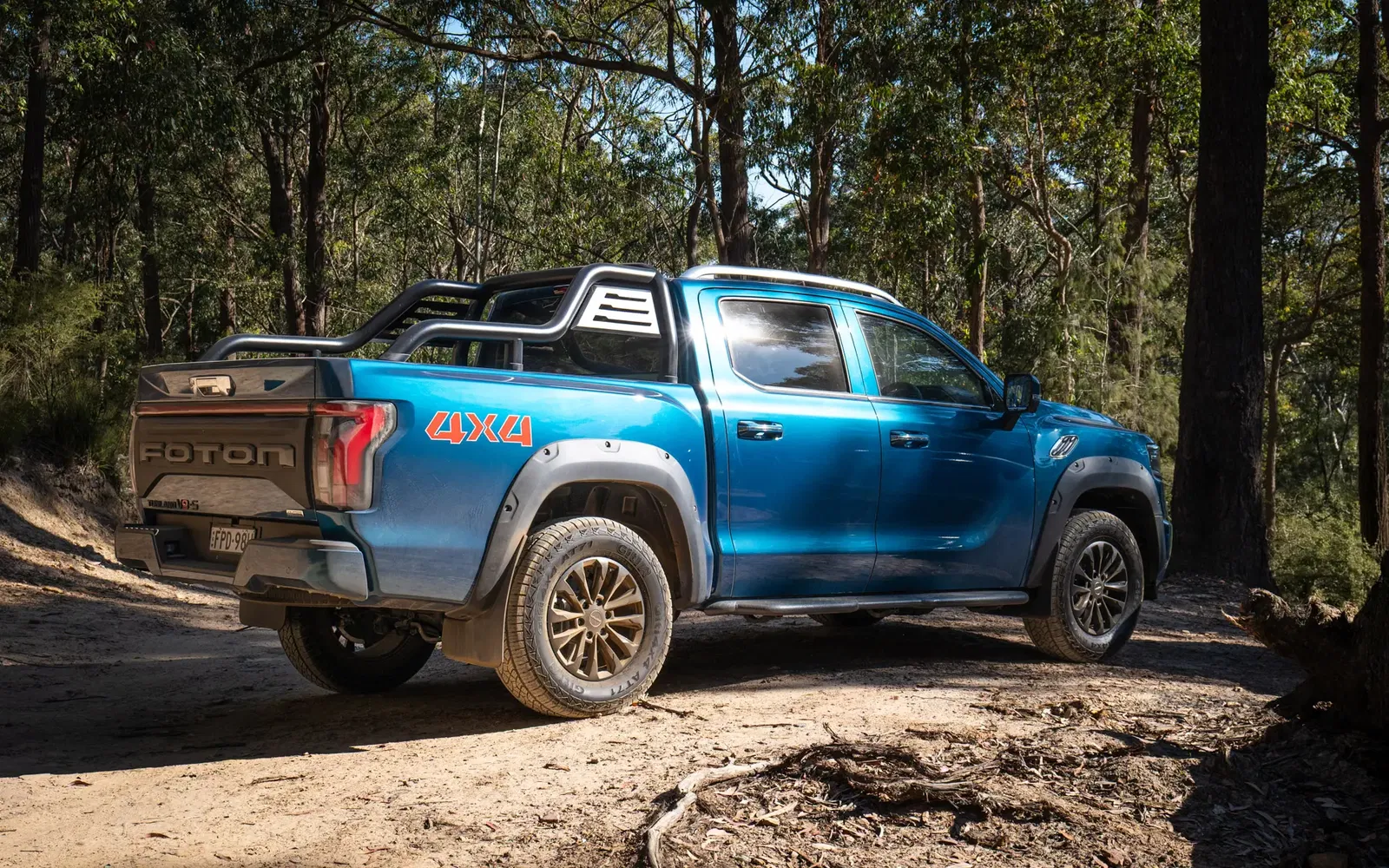
All Variants Created (mostly) Equal
The 2026 Foton Tunland is yet to be tested by ANCAP, making it difficult to comment on its overall safety performance. However, aside from a Driver Monitoring System – which is exclusively offered on the range-topping V9-S – every Tunland variant gets the full suite of safety features on offer.
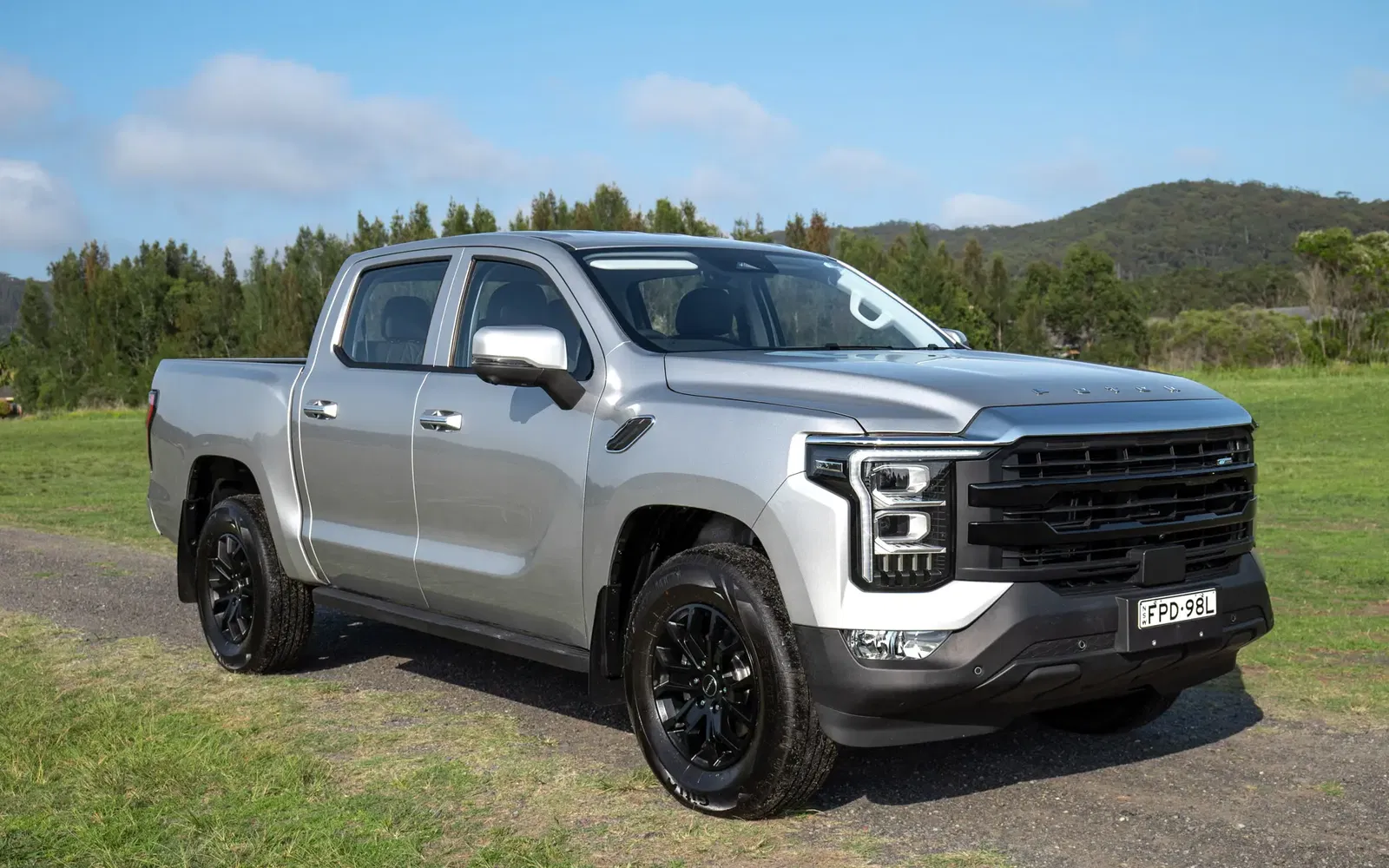
Standard safety features on the Tunland include Adaptive Cruise Control, Lane Keep Assist, Lane Centring Control, Rear Cross Traffic Alert, Front and Rear Parking Sensors, and a 360-degree view monitor, just to name a few.
Standard safety features on the Foton Tunland include:
- Airbags (Dual Front, Dual Side, Dual Full Length Curtain, Driver’s knee, Centre)
- Three-point seatbelts w/ Pretensioners
- Seat Belt Reminders (front and rear)
- Driver and Front Passenger Headrests
- Rear seat headrests w/ three-position adjustment
- Driver and Front Passenger Height Adjustable Seat Belts
- Child Seat Anchor Points (x3)
- ISOFIX Anchor Points for Two ISOFIX Compliant Child Restraints
- Rear Door Child Lock
- Electronic Stability Control
- Anti-Lock Braking System
- Electric Brakeforce Distribution
- Vehicle Dynamics Control
- Traction Control System
- Hydraulic Brake Assist
- Hill-Hold Control
- Hill Descent Control
- Hydraulic Brake Boost
- Auto Vehicle Hold
- Electronic Parking Brake
- Overspeed Alert
- Panoramic 360-degree View Monitor
- Transparent Chassis Monitor
- Front Parking Sensors
- Rear Parking Sensors
- Speed Sensing Door Locks
- Automatic Crash Unlocking
- Fuel Cut Function
- Adaptive Cruise Control
- Autonomous Emergency Braking w/ Pedestrian & Cyclist Alert
- Front Collision Warning
- Lane Departure Warning
- Lane Keep Assist
- Lane Centring Control
- Pedestrian Collision Warning
- Traffic Sign Recognition
- Emergency Signal System
- Blind Spot Detection
- Door Open Warning
- Rear Cross Traffic Alert
- Trailer Stability Assist
The V9-S adds:
- Driver Monitoring System (Distraction Warning and Fatigue Warning)
Strong on Paper
While we haven’t had a chance to evaluate the 2026 Foton Tunland’s towing capability in the real world, its figures look extremely promising.
All variants have a 750kg unbraked and a 3,500kg braked towing capacity. The maximum tow ball down weight across the range is 350kg.

Gross Vehicle Mass ranges between 3,305kg in the V7-C 4X2 and 3,335kg in the V7-C 4X4.
As for Gross Combined Mass, the V7-C 4X2 has the lowest in the range at 6,805kg, while the V7-C 4X4 has the greatest GCM of the lineup at 6,835kg.
When it comes to GVM and GCM, the Tunland boasts some of the strongest figures in the market for a ute of this size and at this price point.
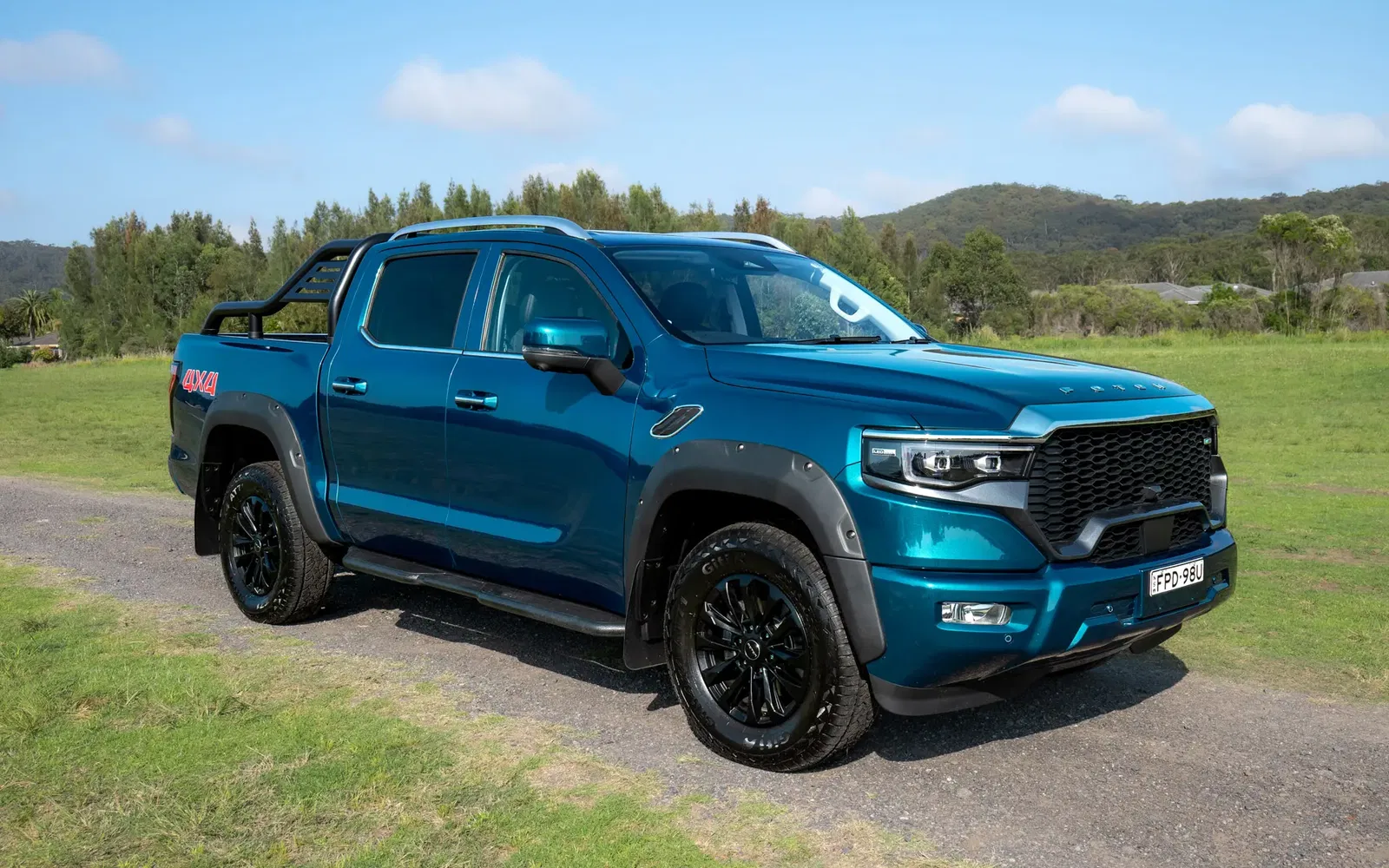
The GWM Cannon Alpha PHEV is one of the few rivals with comparable specs, with a GVM of 3,495kg and a GCM of 6,745kg. Realistically, the only utes with GVM and GCM specs much greater than the Tunland’s are full-size American pick-up trucks, which are significantly more expensive.
It remains to be seen how the Tunland fares in real-world towing, but the numbers place it among some of the best utes on offer.
2026 Foton Tunland Braked Towing Capacity
- V7-C 4X2: 3,500kg
- V7-C 4X4: 3,500kg
- V9-L 4X4: 3,500kg
- V9-S 4X4: 3,500kg
2026 Foton Tunland Gross Vehicle Mass (GVM)
- V7-C 4X2: 3,305kg
- V7-C 4X4: 3,335kg
- V9-L 4X4: 3,310kg
- V9-S 4X4: 3,310kg
2026 Foton Tunland Gross Combined Mass (GCM)
- V7-C 4X2: 6,805kg
- V7-C 4X4: 6,835kg
- V9-L 4X4: 6,810kg
- V9-S 4X4: 6,810kg
Not Bad, But Not a Standout
The 2026 Foton Tunland is offered with a seven-year, unlimited-kilometre warranty and seven years of roadside assist. This represents a strong showing among utes on offer in Australia.
It’s also offered with a seven-year, 110,000km capped-price servicing program, with service intervals coming every 12 months or 15,000km. Prices for each service range between $418.73 and $1,158.87, with the total cost over seven years coming to $4,492.39. While the length of the Tunland’s capped-price servicing program is solid, it’s far from the cheapest on offer.
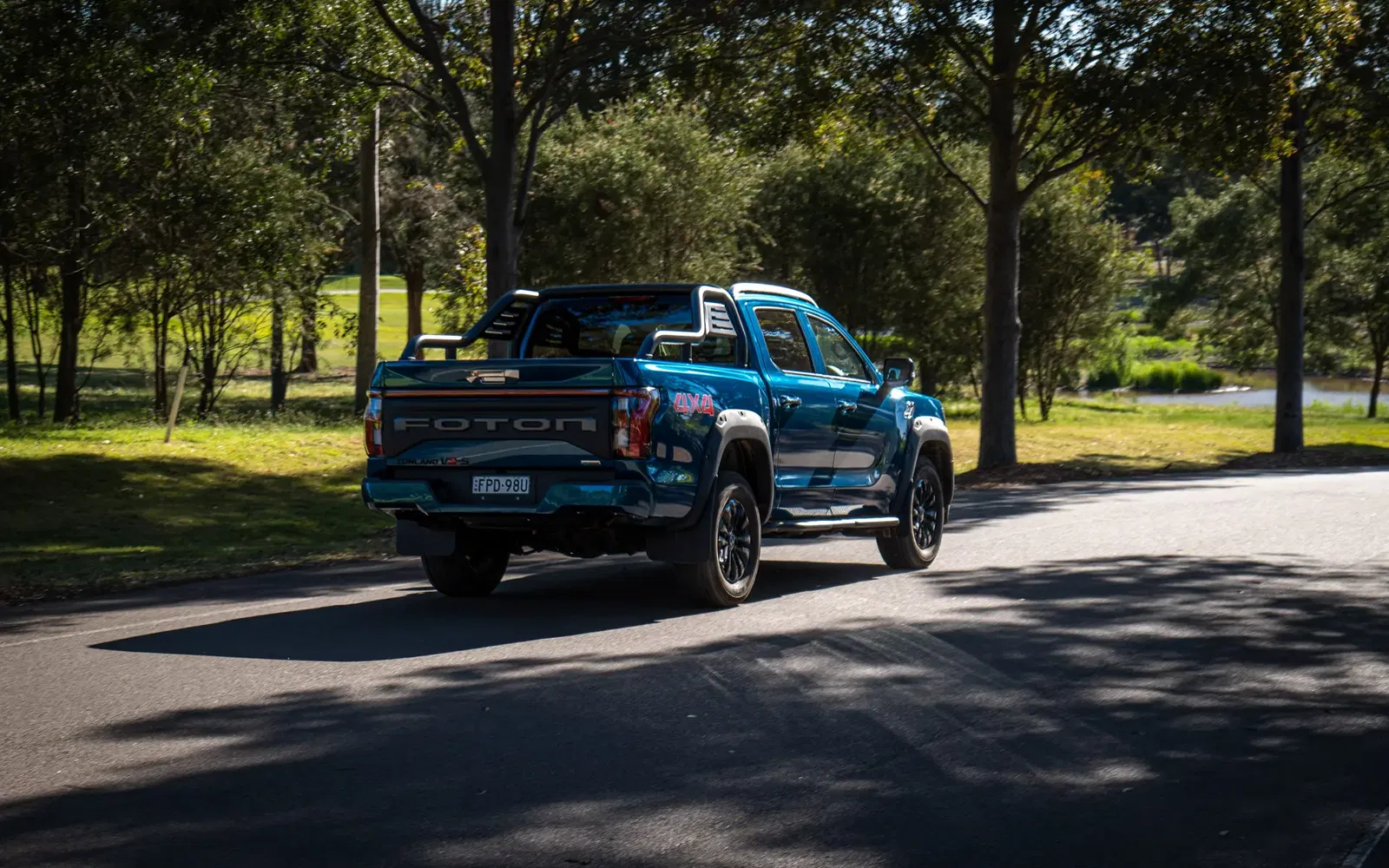
The Tunland also requires AdBlue. Specifically, it has a 12-litre AdBlue tank. While this isn’t exactly uncommon among modern diesel ute offerings, there are still models among the Tunland’s roster of rivals that don’t need it, such as the LDV Terron 9, GWM Cannon Alpha, and the KGM Musso.
What do you get with the 2026 Foton Tunland?
The 2026 Foton Tunland V7-C 4X2 comes standard with:
- 2WD drivetrain
- Drive modes: Eco / Standard / Sport
- Electric power-assisted steering w/ Sport / Comfort / Light modes
- Double wishbone front suspension
- Leaf-spring rigid rear axle
- Rear differential lock (not available)
- 18-inch gloss black alloy wheels
- Steel spare wheel
- Chrome front grille
- Side steps
- Power-adjustable door mirrors w/ indicators
- Green glass (front and rear)
- Front & rear mudguards
- LED daytime running lights, headlights w/ dusk sensing & height adjust, and tail lights
- “Follow Me Home” headlight function
- Synthetic leather trim (black)
- Six-way manually adjustable driver’s seat
- Four-way manually adjustable passenger’s seat
- 60/40 split fold-up & fold-down rear seats
- Automatic single-zone air-conditioning
- Centre armrest w/ air conditioning vent
- Rear air vents
- 12.3-inch digital instrument cluster
- 14.6-inch infotainment touchscreen
- Bluetooth Connectivity
- AM/FM radio
- Four-speaker audio
- 256-colour ambient lighting
- Front LED reading lights
- Halogen rear roof light
- Smart key entry & push-button start
- Rain-sensing wipers
- Power windows (driver auto up/down with jam protection)
- 12 V/120 W power outlet
- USB-A ports (x2)
- Voice Control
- Integrated dash camera w/ panoramic view (Micro SD required)
- Rear seat centre armrest w/ cupholders
- Active DPF regeneration switch
- Tailgate assist Struts
- Decorative board
- Spray-in tub liner
- Inner rope hooks
The V7-C 4X4 adds or replaces:
- Part-time 4WD system (Auto/2H/4H/4L)
- Rear differential lock (auto-disconnect below 38 km/h)
- Off-Road Drive Modes (Sand/Mud/Snow)
The v9-L 4X4 adds or replaces:
- Multi-link rigid rear axle
- Premium side steps
- Key-locking tailgate
- Sports bar
- 220V/300 W Vehicle-to-Load power socket
- USB-A ports (x4)
- Six-speaker audio system
- Dual-zone automatic climate control
- Heated door mirrors with power-folding function
- Automatic anti-glare rear-view mirror
- 18W wireless charging pad
- Six-way power adjustable driver’s seat w/four-way lumbar
- Six-way power adjustable passenger’s seat
- Heated front seats
The V9-S 4X4 adds or replaces:
- Front differential lock
- Chrome tray handle
- Privacy glass (rear doors, rear quarters, rear window)
- Roof rails
- Panoramic sunroof w/ electric sunshade
- LED rear roof lighting
- Power windows (all with auto up/down & jam protect)
- Driver’s seat memory,
- Ventilated front seats
- Heated second-row seats
- Facial recognition (3 profiles)
Final Thoughts
The 2026 Foton Tunland marks a strong return for the brand in Australia. Relative to its price, it’s a lot of ute for the money, and boasts strong practicality, interior and exterior design, off-road capability, and – while its performance is yet to be evaluated in full – has all the right specs for towing.
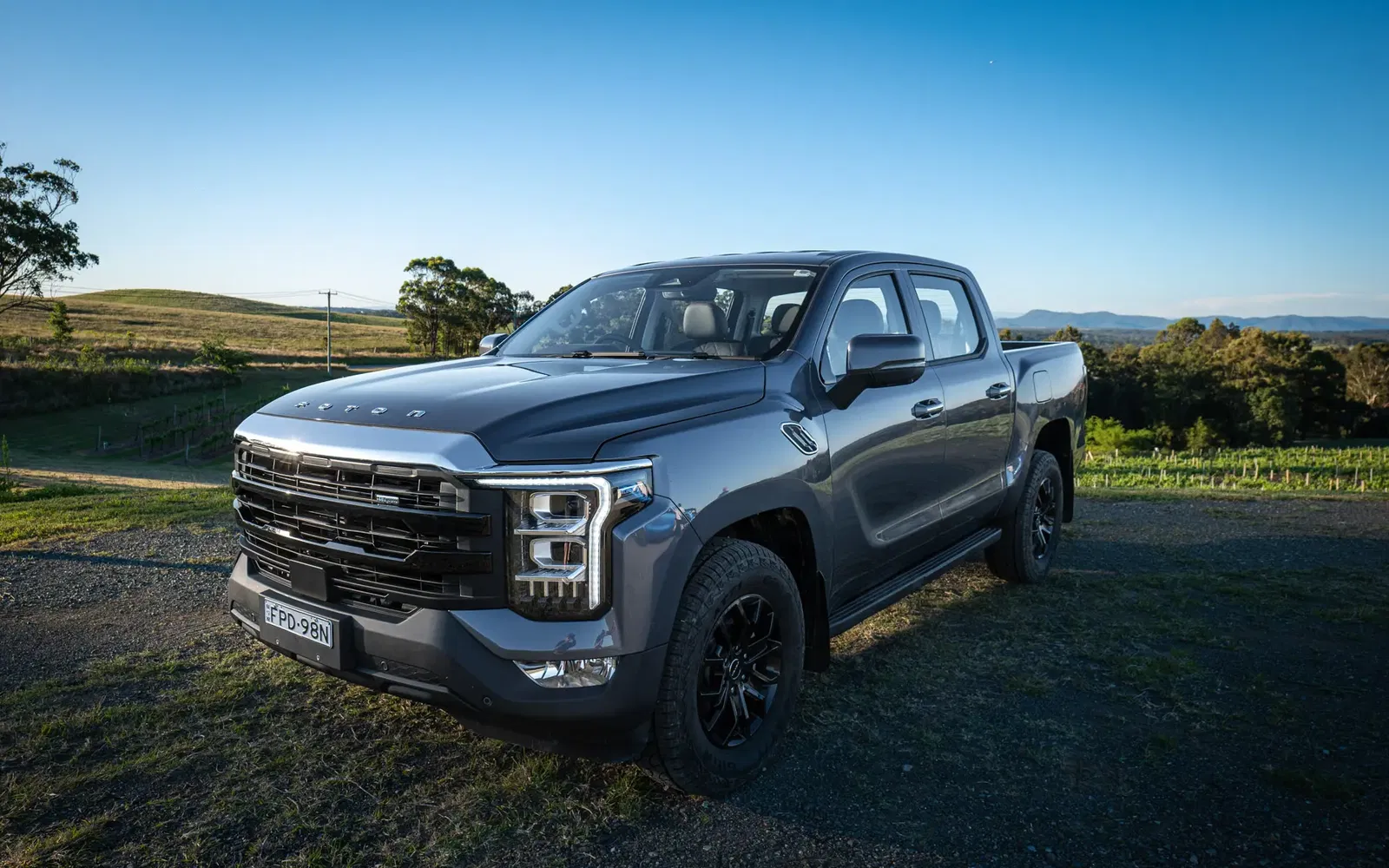
However, it does have some glaring shortcomings, chief among which is its lacklustre powertrain, as well as certain unrefined characteristics of its on-road driving experience. Even still, while lacking in absolute polish, the Tunland’s experience on the road is arguably redeemed somewhat by its ride and handling.
Relative to its price, though, the 2026 Foton Tunland certainly has a lot to offer. If this is a sign of things to come, then Tunland’s second crack at the Australian car market is set to be a strong one.
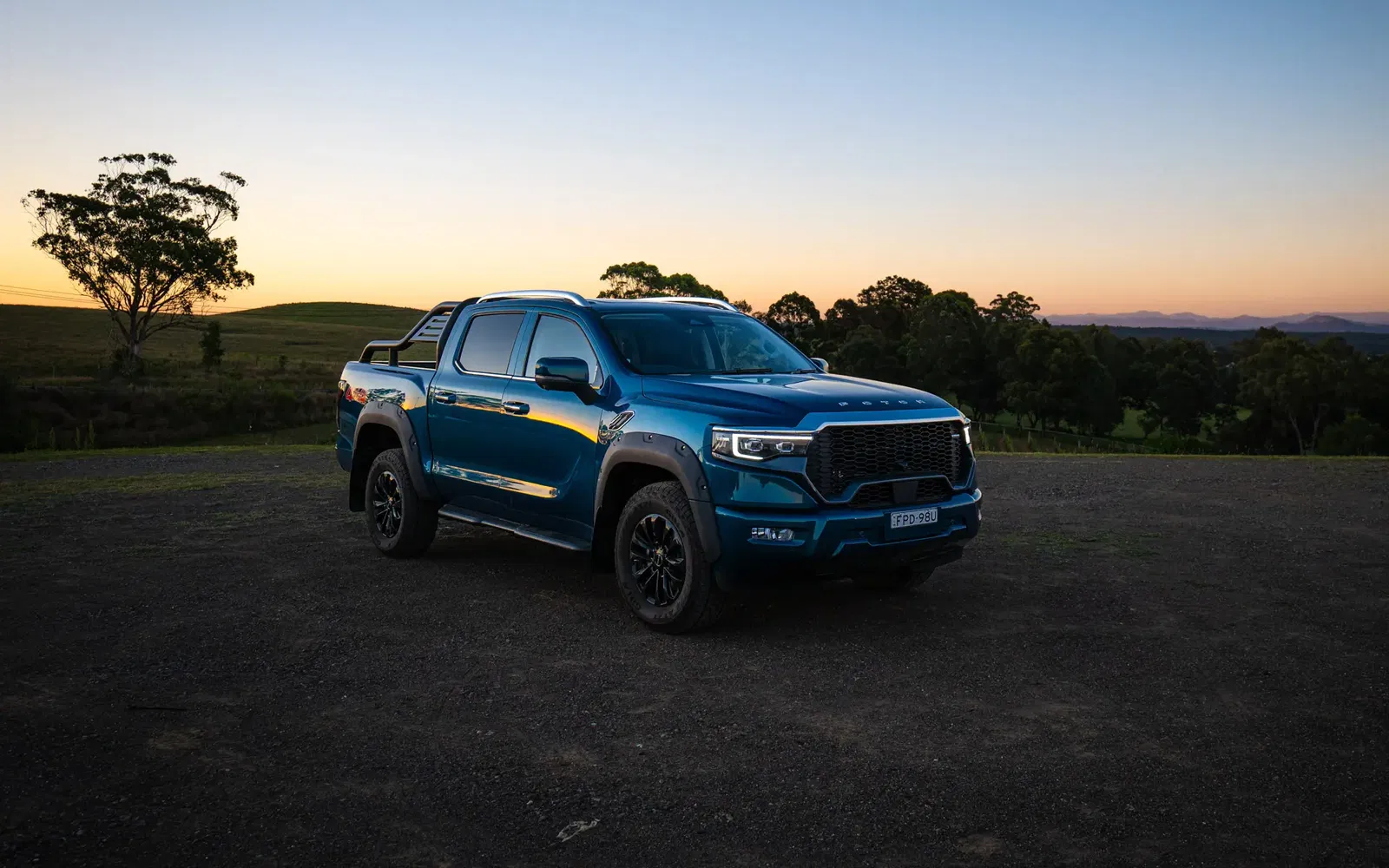
Saucey rating breakdown
Saucey rating breakdown
FAQ
Sign up to our newsletter
Be the first to know when we drop new car reviews.
.avif)

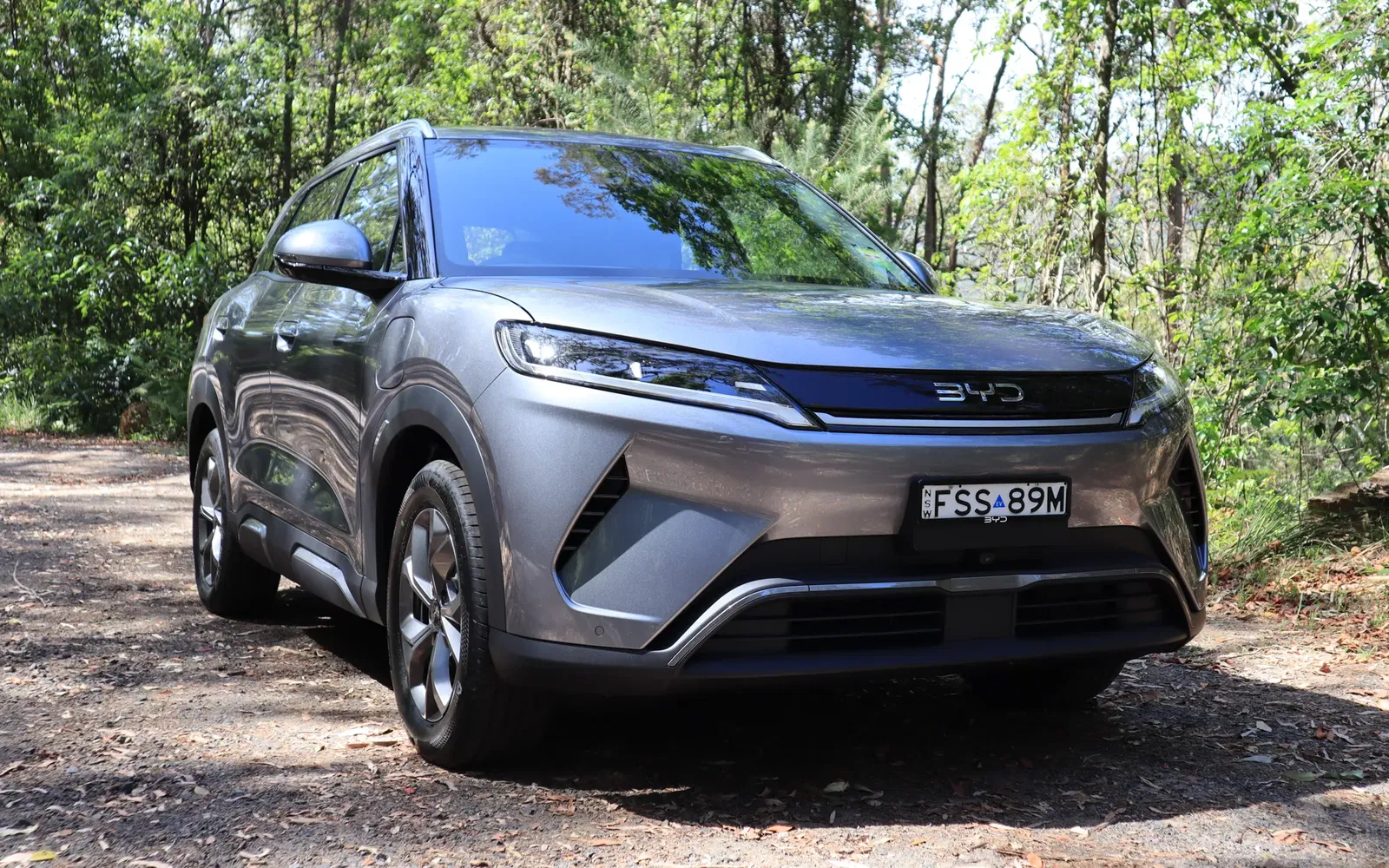

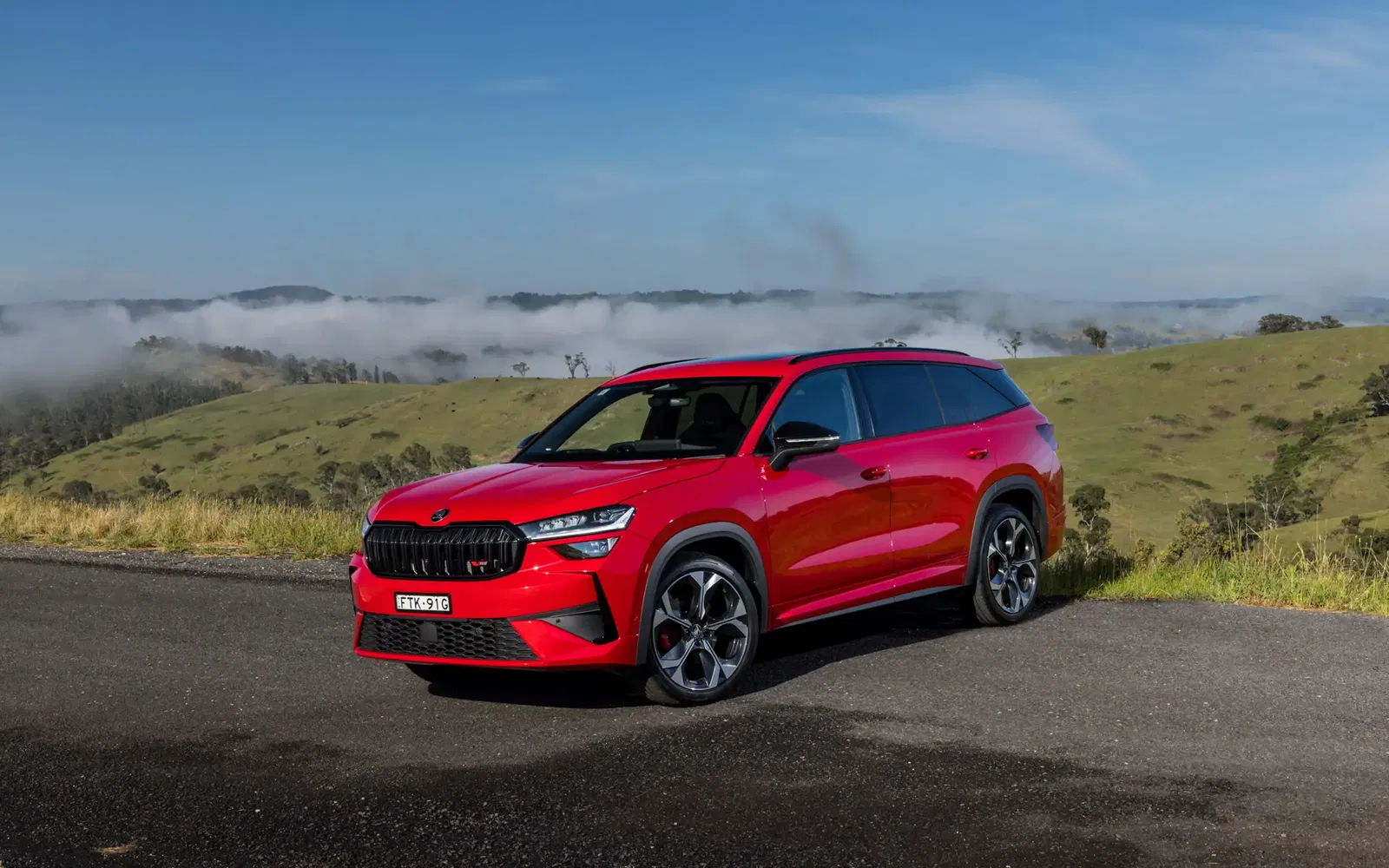
%20Calligraphy%20-%2003.webp)